

















































PAR 4 IN THE



Buc-ee’s opened its first Mississippi location on June 9 in Pass Christian to big crowds and bigger fanfare.
The Harrison County location is served by Coast Electric.
Guy Johnson, Coast Electric’s vice president of economic development and sustainability, said the cooperative is proud to provide electric power to the state’s first Buc-ee’s.
“Part of our mission as a local electric cooperative is to support economic development in our community. Buc-ee’s has already had a positive impact on our local economy, creating hundreds of jobs and increasing sales tax revenue in our area. We will work with Buc-ee’s representatives to ensure they, and their millions of guests, will receive reliable service from Coast Electric,” Johnson told Today in Mississippi.
“Part of our commitment to the project is constructing a new substation to serve Buc-ee’s and the anticipated additional load that will come as a result of their new location in our service area.”
The new store is approximately 74,000 square-feet and features 120 gas pumps.
More than 1,000 fans attended the grand opening, according to the Clarion Ledger.
The new Buc-ee’s is located o Interstate 10 at the Menge Avenue exit in Pass Christian.




Grand Gulf Nuclear Station, Mississippi’s first and only nuclear power plant, turns 40 this year.
In 1980, South Mississippi Electric Power Association — known today as Cooperative Energy — acquired a 10% undivided ownership stake in the Port Gibson-area power plant. The remaining 90% is owned and operated by Entergy subsidiary, System Energy Resources, Inc.
Under the partnership, Cooperative Energy funded 10% of the plant’s construction costs and covered the same amount of its operating and manufacturing expenses and future decommissioning costs. In exchange, Cooperative Energy garners 10% of the electric power generated by the plant.
“For four decades, Grand Gulf has grown into a regional powerhouse, providing safe, clean, carbon-free, a ordable energy while serving as one of the largest non-carbon emitting power plants in the world,” said Mark Smith, senior vice president of power generation at Cooperative Energy.
“In other words, the qualities that made Grand Gulf a sound investment in the 1970s are the same ones that continue providing benefits for Mississippi communities and the environment today.”
About 40,000 tons of reinforced steel and 460,000 cubic yards of concrete were used to build Grand Gulf Nuclear Station. Crews broke ground on the plant in 1974.
Cooperative Energy, based in Hattiesburg, is a generation and transmission electric cooperative that provides power to 11 distribution electric cooperatives around the state — Coahoma Electric, Delta Electric, Twin County Electric, Yazoo Valley Electric, Southern Pine Electric, Dixie Electric, Southwest Electric, Magnolia Electric, Pearl River Vally Electric, Coast Electric, and Singing River Electric.



“Improving the quality of life for all those we touch.”
Service. The word may sound generic, but to us – your local electric cooperative – it means everything.
4-County Electric Power Association was created to serve our communities. Back in the day, neighbors banded together and formed our co-op for the common good. In our case, it was the only way the community could bring electricity to the area where there was none. In doing so, 4-County helped our communities thrive. That mission-focused heritage is the golden thread that is woven throughout our history.
Today, we are continuing to power the community – even as we battle a series of early summer thunderstorms. While our focus has remained steady on providing reliable energy to our members, today’s energy landscape and consumer expectations are far di erent than they were decades ago. That’s why we’re adapting, to keep pace with changing technology, evolving needs and new expectations.
Serving as your trusted energy advisor means we want to help you save energy (and money) and provide advice and information on a broad range of energy topics. For example, if you’re looking for ways to save energy, check out the pages of Today in Mississippi, our website at 4county.org, and talk to our energy saving advisors for energy-saving tips and ideas to increase the energy e ciency of your home. Consider scheduling an energy audit with one of our energy experts to identify ways you can save energy at home. Understanding how your home uses energy can
help determine the best ways to modify energy use and thereby keep more money in your wallet.
So, the next time you hear 4-County use the phrase “we’re here to serve you,” we hope you know that we mean it. Service is deeply ingrained into who we are. We continue to evolve with the times, and in return, we’ve found additional ways to serve you and provide more options for you to power your life.
We’re here whenever you need us. Connect with us online, in person, by phone or through our social media channels. However you choose to connect, please let us know how we can serve you better.
And, in conclusion, I’d like to thank our members, board of directors and employees for making our 2025 annual meeting a huge success. Nearly 700 members, employees, and o cials of 4-County Electric Power Association attended the cooperative’s annual membership meeting Thursday, June 5, at the East Mississippi Community College Golden Triangle campus. See photos and related article on pages 16 and 17.

by Brian Clark
CEO/General Manager



Interested in a speaker or electrical safety/ education display for your club or organization?


The 4-County/FASTnet Speakers Bureau and Community Service Program may be right for you. The co-op has speakers available for a variety of topics and demonstrations, including electrical safety, electrical e ciency, fiber internet education, and hot line demonstrations. Call us at 1-800-431-1544 for more information. Ask for the marketing department.



























Some 700 members of the 4-County Electric Power Association attended the cooperative’s annual membership meeting Thursday, June 5, at the East Mississippi Community College’s Golden Triangle campus in Mayhew.
The co-op members began gathering about 9 a.m. for registration and entertainment. They were later treated to a catfish lunch prepared and cooked by 4-County employees, elected two directors (Johnny Johnson, District 1 Lowndes County and Marty Crowder, District 5 Choctaw & Winston counties), and heard financial and business reports from 4-County o cials. Board President Marty Crowder discussed the history of cooperatives, highlighting the importance that electricity has played in the area’s growth and development. CEO Brian Clark said the co-op is celebrating the


4-County Foundation’s 10th anniversary this year. The program is rapidly approaching $2.5 million of distributions. Over 500 awards have been distributed to area non-profit organizations since the program’s inception in 2015.
4-County Youth Tour delegates Armando Dunand, Hayes Carver, and Carey Beth Honnoll were recognized, and the trio provided reports to members about their leadership activities.
Members returning their proxy/ballots, as well as those who attended the meeting, qualified to win valuable prizes. Those attending the meeting qualified for the grand prize, a retired 4-County fleet vehicle. Mike Simmons of West Point was the winner of the Jeep Grand Cherokee. Other attendee prizes included home electronics and more.

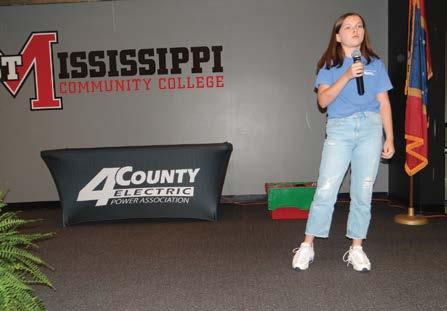























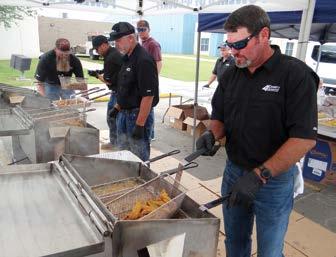



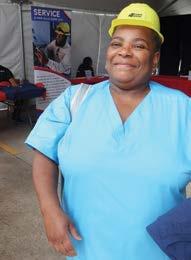





network of precision with endless possibilities. At night, he turns into a family man — husband to Amber and father to 1- year-old Nora.
And, when he can, he spends a little time in his own little fantasy world — one that has its own defined set of rules that can lead to unlimited scenarios. Ryan, a FASTnet fiber network analyst, enjoys 3-D printing and fantasy board games. He has even purchased a 3-D resin printer that creates characters and terrains, corresponding with the game’s twists and turns.
“For me, it’s a great way to express creativity,” Ryan explained. “It helps expand my imagination. And, sometimes, it can be an escape from a harsh world. But, ultimately, it’s a great way to spend time with friends and keep everyone o of their cell phones.”
Resin 3D printing, also known as stereolithography, uses a liquid resin that solidifies when exposed to UV light. The process involves several steps that work together to transform a liquid resin into a solid object:
• First, fill the printer reservoir with liquid resin. This resin is photosensitive, meaning it hardens when exposed to UV light.
• In the next step, the printer uses a laser to trace and solidify each layer. A platform inside the printer moves up and down, dipping into the resin while the UV light hardens the areas needed for that layer. The process continues, layer by layer, until the object is formed.



“The process is a lot of fun,” Ryan said.
Working with technology is a lot of fun, too, he added. “I built my first computer when I was 9. I helped my dad. I was hooked. At 14, I was building computers for my friends. I never thought about it as a career, then.”
As an adult, he worked as a project manager for a construction company before the allure of computers drew him to East Mississippi Community College, where he received an associate’s degree in network technology. Ryan came to 4-County in June 2023.
His duties include interaction with FASTnet customers, ensuring their connections are secure and troubleshooting when they are not. He also assists with the phone components of FASTnet, maintaining the 17 communication hubs.
Ryan lives in Starkville with his family and a friendly German Shorthaired Pointer, a ectionately named after his favorite NFL team. “Titan has been a great addition to our family.”
Family is important to Ryan. “I love spending time with my family. And 4-County is a family-oriented place, too. What we do here is bigger than one individual. It’s great that we can bring fiber to rural America. It’s exciting to be a part of that. I’m grateful to be here and excited for what the future holds.”
















































































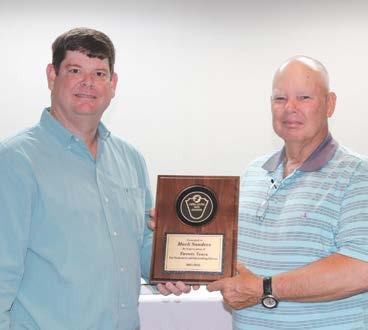



























Central Electric General Manager Brian Long presents plaques to Mark Sanders and Kent Sistrunk.




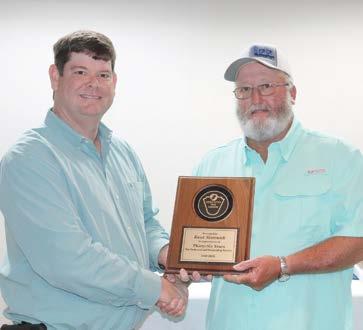

















by Scott Flood
Don’t generate problems with your backup generator.
The wind howls outside your windows as a major storm system blows through the area in the late evening. Your lights flicker for a moment or two before you’re plunged into darkness. The social media feed on your phone is packed with reports of damage and power outages, and the storm shows no sign of letting up for hours.
Fortunately, you had the foresight to buy a backup generator big enough to handle your refrigerator, freezer and other key needs. Flashlight in hand, you attach extension cords. Within minutes, you hear the quiet humming that tells you they’re working again.
Mississippi’s electric cooperatives understand power outages are a major inconvenience, and we do our best to prevent them. But when severe weather rolls through, outages can sometimes stretch into several hours or even days after a major storm. Lineworkers may have to check many miles of power lines to pinpoint the problems before they can begin their work to restore service. That’s why many co-op members consider buying backup generators to provide for their family’s needs while waiting for service to resume.
The biggest danger associated with backup generators is one that’s both invisible and deadly. Because backup generators burn fossil fuels, they generate a variety of gases, most notably carbon monoxide.


Backup generators fall into one of two categories. Standby generators are permanently wired into the home’s electrical system by a qualified electrician. They come in a variety of sizes, so homeowners can match the generator to their home’s power needs. Portable generators, as the name implies, can be moved to wherever they are needed. Because they’re small enough to move, they generally provide less power than standby models. Most use gasoline or diesel fuel, and when they’re operated correctly, both types provide a safe source of backup power.
Some homeowners make the mistake of plugging their backup generators directly into a wall outlet or connect them to their home’s electrical panel. Beyond the significant risk of electrocution and fire that can create, plugging generators directly into your outlets can send the voltage your generator creates into the power lines connecting your home to the electric grid. That creates a dangerous condition called “backfeed,” which can seriously injure the lineworkers who are working so hard to restore your electricity, as well as anyone who accidentally comes in contact with power lines. Backfeed can also damage the generator.
That’s why permanently installed backup generators are required to have what’s known as a transfer switch, which should be installed by a qualified electrician. The transfer switch creates a barrier between your home’s electrical system and the outside wires, so backfeed cannot occur. When the transfer switch senses that power has been restored, it switches the power from the generator back to the outside lines.
The biggest danger associated with backup generators is one that’s both invisible and deadly. Because backup generators burn fossil fuels, they generate a variety of gases, most notably carbon monoxide. According to the Consumer Product Safety Commission, one portable generator can produce as much CO as hundreds of cars. The agency reports that nearly 100 Americans lose their lives each year because of CO poisoning from backup generators. That’s why generators should only be used in dry, well-ventilated areas away from your home and garage.
CO gas is not only invisible, but it’s also odorless. The National Institutes of Health warns that CO has the potential to kill in as little as five minutes. People exposed to CO typically become dizzy, feel nauseated, and experience headaches. Often, they lose consciousness before noticing any symptoms. Anyone exposed to CO should be moved to fresh air immediately.
If you purchase a portable backup generator, protect your home and family by taking the time to read the manufacturer’s instructions. Don’t use portable generators in rainy or wet conditions unless you keep them shielded from moisture and well-ventilated.
When starting a portable generator, make sure nothing is plugged into it. In addition, you can reduce the potential for damage to your appliances and lighting by turning them o or unplugging them from the wall. After the generator starts, plug them in and turn them on one at a time to make sure you aren’t overloading your generator’s capacity. Unplug them from the generator before turning it o . Unless the manufacturer recommends otherwise, always turn the generator o and allow it to cool before adding fuel.
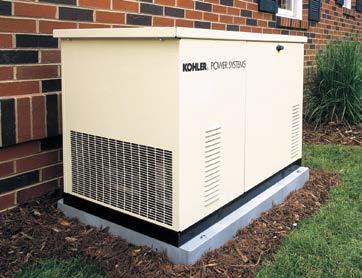

Finally, as with many home appliances, regular maintenance is the key to ensuring your portable generator operates safely for years to come. When storing it, drain the fuel from the tank. In addition, check the oil and fuel level, filters, and other components once a season so you know it will be ready to run safely and e ciently the next time a big storm blows through.
For more than four decades, business writer Scott Flood has worked with electric cooperatives to build knowledge of energy-related issues among directors, sta and members.
















QHow do I improve the e ciency of my older home while keeping its charm?

by Miranda Boutelle
Start by prioritizing the invisible upgrades that make your home more comfortable and e cient. When we were kids, I don’t think any of us thought, “When I grow up, I want to spend my hard-earned money on insulation.” It’s not as exciting as new countertops or a remodeled bathroom, but air sealing and insulation can save you money every month. Then you can apply the savings to aesthetic improvements.
Many older homes are not properly insulated. Insulation has several benefits beyond sealing your home and keeping outdoor air from seeping in. It reduces outdoor noise, makes your home quieter and improves your overall comfort.
Always properly air seal before you insulate. Older homes with pocket doors, coved ceilings, dumbwaiters, doors to attic spaces, and laundry chutes allow indoor air to escape through the cavities, gaps and cracks around these classic features. Sealing o open cavities around those features often requires plywood, rigid foam, or drywall fastened into place and then caulked around the edges.
Keep an eye out for framing features that cause drafts. Balloon framing is a type of construction where wall studs run all the way from the foundation to the roof, allowing air to flow freely through those spaces. Second floors with knee wall attics on both sides are notorious for air leakage. Open cavities allow air to flow horizontally between the attic spaces, making the home uncomfortable and ine cient. Seal o the open cavities in the floor framing and insulate attic spaces.
Dense-packed cellulose or closed cell foam insulation can be sprayed into exterior walls. Skilled contractors can remove pieces of siding and drill holes to fill the wall cavities from the outside of the home. For brick or stone homes, holes can be drilled from the inside and then patched and painted. Insulating walls from the inside of the home requires more time and e ort in preparation and cleanup, but having well-insulated walls is worth it.
Knob and tube wiring — commonly used from the early 1880s to the 1930s with no grounding wire — should be replaced prior to insulating walls and attics for safety purposes. Contact between insulation and knob and tube wiring can create a fire hazard.
People often think new windows are the best way to improve a home’s e ciency. Considering the cost of replacing windows,


AI love old homes. The details and craftsmanship have always drawn me to them. The features of older homes can make them less e cient than modern construction, but it doesn’t have to be that way. You can keep the charm and make your home more e cient.

I recommend investing in air sealing and insulation first. Then consider storm windows to keep the charm of the original windows, such as leaded glass and stained-glass windows in good condition. Choose from interior or exterior options that are operable and inoperable.
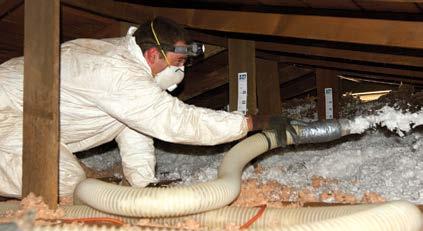
Prioritize the invisible upgrades that make your home more comfortable and e cient, such as adding blown-in insulation to your attic. Photo Credit: Bonneville Power Administration
Once you’ve addressed the envelope of your home, consider appliance improvements. Replace your old electric water heater with a heat pump water heater. This upgrade can save a family of four an estimated $550 per year and more than $5,600 over the lifetime of the water heater, according to ENERGY STAR®. Invest in high-e ciency heating and cooling equipment. A mini-split heat pump, also known as a ductless heat pump, is a more e cient option than electric baseboard heating and provides the benefit of air conditioning.
Older homes don’t have to be ine cient. Show your home some love and invest in energy e cient upgrades.
Miranda Boutelle is the chief operating o cer at E ciency Services Group in Oregon, a cooperatively owned energy e ciency company.

















by Qua’Shara Monix

















When the skies darken and the winds rise, most people seek shelter. For a select few — our linemen — it’s a call to action. These men and women are the unseen heroes who run toward danger to restore power, reconnect communities, and bring light back to those left in the dark. Their work is more than a job — it’s a mission rooted in service, sacrifice, and a powerful sense of brotherhood.



On May 18, 2025, the service territory of Coahoma Electric Power Association (CEPA) was hit hard. Severe thunderstorms, strong winds, and tornado threats ripped across the area, leaving widespread damage in their wake. CEPA, which services 8,369 meters across 1,654 total miles of line, was suddenly thrust into a battle against nature’s fury.



With just 44 full-time employees, CEPA’s team was stretched thin. But in the world of electric cooperatives, no co-op stands alone. Help came swiftly and selflessly. Yazoo Valley Electric Power Association from Yazoo, Twin County Electric Power Association from Hollandale, and 4-County Electric Power Association from Columbus answered the call without hesitation. Together, they sent 23 linemen to assist in Coahoma Electric's restoration e orts, forming a united front against the storm’s aftermath.



Behind the scenes, CEPA’s commitment didn’t stop at the poles and wires. The storm response was a team e ort, and the dedication of CEPA’s o ce sta played a critical role in the success of the restoration e orts. While linemen battled the elements, o ce sta worked around the clock to feed communications between crews, managers, and members. Their diligence ensured clear coordination, fast response times, and steady reassurance to a community in crisis.
Richard Taylor, safety coordinator for Coahoma Electric Power Association, asked all the linemen that assisted to sign a work shirt that had been torn while on the job. The shirt belonged to a lineman actively involved in storm restoration e orts, and Taylor wanted to preserve it as a symbol of the lineman brotherhood. The gesture honored the shared commitment to restoring power safely and the unity and dedication shown by crews working together during challenging times.

We at CEPA are deeply grateful to the crews who traveled from across Mississippi to stand with us. Your presence was not just help, it was hope.
To every lineman who braved the storm, to every family who waited while you worked, and to every cooperative that lent a hand — THANK YOU. You are more than utility workers — you are guardians of community, keepers of the current, and heroes in hard hats.
This response wasn’t about compensation or contracts, it was about commitment. It was about one crew standing in the mud and rain for another, because they know exactly what it means to face down a snapped pole, a live wire, and an urgent need from the community. It’s about that sacred bond among linemen, forged not just in safety training and storm prep, but in sleepless nights, shared meals on tailgates, and quiet victories when the lights finally come back on.
The brotherhood of linemen runs deep. It’s a network built on trust, grit, and an unshakable dedication to serve others, especially when the going gets tough. And in those moments, like the one Coahoma faced in May, that spirit shines brightest.
We’d also like to send a special shout out to Fitzgerald Casino in Tunica Resorts, who went above and beyond to accommodate our visiting volunteers. Your generosity and support made a big di erence in their comfort and morale. To Jack’s Family Restaurant in Tunica, thank you for graciously providing breakfast and lunch to our crews. Your kindness helped fuel the hard work and long hours they put in.
When the storm passed, it wasn’t just power that was restored — it was a powerful reminder of what true service looks like. That is the legacy of the lineman. That is the strength of the brotherhood.
We’re grateful for your support and the strong sense of community that shines through during times like these!



Coahoma Electric Chief Financial O cer Bob Burke awarded Nasir Simpson a scholarship on behalf of The Electric Cooperatives of Mississippi Foundation. The foundation was created in 2005 in an e ort to give back to the communities they serve by providing scholarships for post-secondary and vocational education to accredited institutions for qualifying high school seniors.
Nasir Simpson is a 2025 graduate of West Tallahatchie High School. Nasir is a member of Jobs of MS Graduates and plans to attend Mississippi Delta Community College to pursue a career in fiber optics. Nasir’s advice to underclassmen is, “Don’t let others dim your light.”
Nasir is the son of Anthony “Troy” Simpson. Troy is an apprentice lineman of Coahoma Electric Power Association and has been employed at the co-op for three years.

HAPPY




will observe Independence Day, and our o ces will be closed Friday, July 4, for the holiday.












by Scott Flood
Don’t generate problems with your backup generator.
The wind howls outside your windows as a major storm system blows through the area in the late evening. Your lights flicker for a moment or two before you’re plunged into darkness.
Fortunately, you had the foresight to buy a backup generator big enough to handle your refrigerator, freezer, and other key needs.
Mississippi’s electric cooperatives understand power outages are a major inconvenience, and we do our best to prevent them. But when severe weather rolls through, outages can sometimes stretch into several hours or even days after a major storm. Lineworkers may have to check many miles of power lines to pinpoint the problems before they can begin their work to restore service. That’s why many co-op members consider buying backup generators to provide for their family’s needs while waiting for service to resume.
Backup generators fall into one of two categories. Standby generators are permanently wired into the home’s electrical system by a qualified electrician. Portable generators, as the name implies, can be moved to wherever they are needed. Because they’re small enough to move, they generally provide less power than standby models.
Some homeowners make the mistake of plugging their backup generators directly into a wall outlet or connect them to their home’s electrical panel. Beyond the significant risk of electrocution and fire that can create, plugging generators directly into your outlets can send the voltage your generator creates into the power lines connecting your home to the electric grid. That creates a dangerous condition called “backfeed,” which can seriously injure the lineworkers who are working so hard to restore your electricity, as well as anyone who accidentally comes in contact with power lines.
That’s why permanently installed backup generators are required to have what’s known as a transfer switch, which should be installed by a qualified electrician. The transfer switch creates a barrier between your home’s electrical system and the outside wires, so backfeed cannot occur. When the transfer switch senses that power has been restored, it switches the power from the generator back to the outside lines.
The biggest danger associated with backup generators is one that’s both invisible, odorless, and deadly. Because backup generators burn fossil fuels, they generate a variety of gases, most notably carbon monoxide. The agency reports that nearly 100 Americans lose their lives each year because of CO poisoning from backup generators. That’s why generators should only be used in dry, well-ventilated areas away from your home and garage.




CO has the potential to kill in as little as five minutes. People exposed to CO typically become dizzy, feel nauseated, and experience headaches. Often, they lose consciousness before noticing any symptoms. Anyone exposed to CO should be moved to fresh air immediately.
If you purchase a portable backup generator, protect your home and family by taking the time to read the manufacturer’s instructions. Don’t use portable generators in rainy or wet conditions unless you keep them shielded from moisture and well-ventilated.
When starting a portable generator, make sure nothing is plugged into it. In addition, you can reduce the potential for damage to your appliances and lighting by turning them o or unplugging them from the wall. After the generator starts, plug them in and turn them on one at a time to make sure you aren’t overloading your generator’s capacity. Unplug them from the generator before turning it o . Unless the manufacturer recommends otherwise, always turn the generator o and allow it to cool before adding fuel.
Finally, as with many home appliances, regular maintenance is the key to ensuring your portable generator operates safely for years to come.
For more than four decades, business writer Scott Flood has worked with electric cooperatives to build knowledge of energy-related issues among directors, sta and members.















our members have the power












Electric co-ops exist to provide a source of safe, reliable electricity for our members. We also exist to strengthen our communities and improve the quality of life for the people we serve. To do this successfully, we need sound leaders with a vision for our members. I have had the privilege of serving Coast Electric members as the president and CEO of our co-op and CoastConnect subscribers since 2020. In January, I will retire and, while I will miss the day-to-day interactions with Coast Electric employees and members, I know our board of directors have selected a new president and CEO who will lead the company in a positive direction for years to come. You can learn more about the new CEO, Chris Rhodes, on the following pages. Chris and I will be working together until my retirement. I hope you will give him the same support that I have received from each of you over the years.
Our Annual Meeting in November will be a great time for you to meet Chris, and I hope you will make plans to attend. If you can’t join us in person, we hope you will fill out the registration forms

we will be mailing to your homes later this month. Be sure to check your mailbox and your inbox for registration information. As usual, we will be giving away electricity credits of up to $1,000 for those who attend and register. As a bonus this year, all registrants and attendees will be eligible to win a retired fleet vehicle. We believe this exciting new addition to our prize list will encourage even more members to participate in our election process. Having more members who are active and engaged helps us understand your needs and helps us make decisions that will improve your service. I hope to see you all in November!
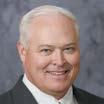
by Ron Barnes
President and CEO


Save the date! Join us Thursday, Nov. 6, at our Kiln headquarters for our 2025 Annual Meeting. Can’t make it? We’ve got you covered. Registration via mail and online begins July 30. There will be prizes for those attending the meeting and for those who register their proxy. Stay tuned to Today in Mississippi, coastelectric.coop and our social media outlets for information.





Coast Electric’s Board of Directors is pleased to announce that Chris Rhodes will be the next president and chief executive o cer (CEO) of Coast Electric and CoastConnect. Chris is replacing Ron Barnes upon his retirement in early 2026 after eight years as Coast Electric’s CEO.
Chris comes to Coast Electric from Southern Pine Electric, an electric cooperative serving 70,000 members headquartered in Taylorsville. He has served as the CEO of Southern Pine since 2020 and has a long history of leadership in cooperatives in Mississippi. Before taking on his leadership role at Southern Pine, Chris worked for Cooperative Energy, a generation and transmission cooperative with headquarters in Hattiesburg that provides power to 11 distribution cooperatives like Coast Electric. He has served in engineering, supervisory and management roles, including serving as a plant engineer and manager, directing external a airs and economic development activities, and managing legislative activities.
“Chris has extensive knowledge of and experience in many aspects of the electric cooperative industry,” said Coast Electric board chair James Baldree. “He has a record of successfully leading cooperative employees, working to improve the lives of co-op members and promoting the rural areas co-ops serve. His expertise and leadership style will be a benefit not only to co-op employees but to our community.”
Chris will work side-by-side with Ron until Ron’s retirement later in the year.
benefit
Coast Electric’s commitment to our community includes environmental stewardship. Coast Electric employees spend hours donating their time and e orts to various environmental projects that ensure the natural beauty of our community is preserved. As part of the cooperative’s commitment to our environment, Coast Electric employees play an active role in cultivating and maintaining community gardens in the area. Employees recently spent time working at the Schwan Property, a pollinator garden in D’Iberville that co-op employees maintain in partnership with the Land Trust for the Mississippi Coastal Plain. Besides mowing and weeding the property, employees installed new plants, signs and structures in the garden. Additionally, a ribbon-cutting celebration was held for the community garden at the Pearlington Library in Hancock County. Besides providing labor and materials for the garden, Coast Electric was able to fund the garden in part with a grant from the Sharing Success program through CoBank, a cooperative bank that serves utilities in rural America like Coast Electric. Coast Electric is one of several community partners working with the library to make the garden a success. The food grown in the garden is for Pearlington residents and helps those in the area who are food insecure.

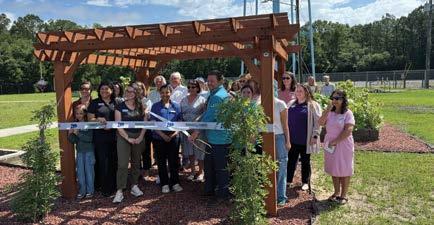
Coast Electric wants you to reduce your energy use and see savings on your energy costs. Each month, you will have an opportunity to register to win a prize that will help you reduce the energy consumption in your home. Visit coastelectric.coop or scan the QR code to enter. It only takes a few seconds, and you could win a prize that helps you save!
Congratulations to our May winner, Karen Lepoma
































QHow do I improve the e ciency of my older home while keeping its charm?

by Miranda Boutelle
Start by prioritizing the invisible upgrades that make your home more comfortable and e cient. When we were kids, I don’t think any of us thought, “When I grow up, I want to spend my hard-earned money on insulation.” It’s not as exciting as new countertops or a remodeled bathroom, but air sealing and insulation can save you money every month. Then you can apply the savings to aesthetic improvements.
Many older homes are not properly insulated. Insulation has several benefits beyond sealing your home and keeping outdoor air from seeping in. It reduces outdoor noise, makes your home quieter and improves your overall comfort.
Always properly air seal before you insulate. Older homes with pocket doors, coved ceilings, dumbwaiters, doors to attic spaces, and laundry chutes allow indoor air to escape through the cavities, gaps and cracks around these classic features. Sealing o open cavities around those features often requires plywood, rigid foam or drywall fastened into place and then caulked around the edges.
Keep an eye out for framing features that cause drafts. Balloon framing is a type of construction where wall studs run all the way from the foundation to the roof, allowing air to flow freely through those spaces. Second floors with knee wall attics on both sides are notorious for air leakage. Open cavities allow air to flow horizontally between the attic spaces, making the home uncomfortable and ine cient. Seal o the open cavities in the floor framing and insulate attic spaces.
Dense-packed cellulose or closed cell foam insulation can be sprayed into exterior walls. Skilled contractors can remove pieces of siding and drill holes to fill the wall cavities from the outside of the home. For brick or stone homes, holes can be drilled from the inside and then patched and painted. Insulating walls from the inside of the home requires more time and e ort in preparation and cleanup, but having well-insulated walls is worth it.
Knob and tube wiring — commonly used from the early 1880s to the 1930s with no grounding wire — should be replaced prior to insulating walls and attics for safety purposes. Contact between insulation and knob and tube wiring can create a fire hazard.
People often think new windows are the best way to improve a home’s e ciency. Considering the cost of replacing windows,


AI love old homes. The details and craftsmanship have always drawn me to them. The features of older homes can make them less e cient than modern construction, but it doesn’t have to be that way. You can keep the charm and make your home more e cient.

I recommend investing in air sealing and insulation first. Then consider storm windows to keep the charm of the original windows, such as leaded glass and stained-glass windows in good condition. Choose from interior or exterior options that are operable and inoperable.

Prioritize the invisible upgrades that make your home more comfortable and e cient, such as adding blown-in insulation to your attic. Photo Credit: Bonneville Power Administration
Once you’ve addressed the envelope of your home, consider appliance improvements. Replace your old electric water heater with a heat pump water heater. This upgrade can save a family of four an estimated $550 per year and more than $5,600 over the lifetime of the water heater, according to ENERGY STAR®. Invest in high-e ciency heating and cooling equipment. A mini-split heat pump, also known as a ductless heat pump, is a more e cient option than electric baseboard heating and provides the benefit of air conditioning.
Older homes don’t have to be ine cient. Show your home some love and invest in energy e cient upgrades.
Miranda Boutelle is the chief operating o cer at E ciency Services Group in Oregon, a cooperatively owned energy e ciency company.







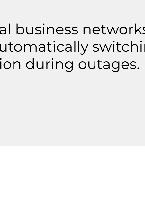



pairs. If a storm damages any member-owned equipment, the member is pairs. Members should hire a licensed electrician epairs to member











members (“Members”) have the right to use,




















Electric Co-op Owned Equipment vs Member-Owned Equipment






As July rolls in with longer days and rising temperatures, it also brings the increased potential for severe weather. Summer storms can arrive quickly and hit hard, sometimes causing significant damage to essential electric equipment throughout our community.
to member-owned equipment.
Delta Electric is always prepared to respond swiftly to outages and restore power safely, but it is also important for homeowners to understand which parts of the electric system are their responsibility and which are maintained by us at the co-op. Understanding these key di erences can help speed up repairs and ensure everyone stays safe when the weather turns rough.
Delta Electric is responsible for maintaining and repairing the equipment and lines that run to your home, including utility poles, distribution power lines, electric meters, and padmounted transformers.
Delta Electric members are responsible for the equipment located between the electric meter and your home or business. Members are also responsible for the weatherhead and service mast located outside the home.
If any equipment that you (the homeowner) are responsible for is damaged, please call a licensed electrician to conduct the repairs. A professional has the experience and know-how to assess and manage these types of repairs.
When severe weather damages electrical equipment, it’s important to note that any necessary repairs to the homeowner’s equipment must be conducted before Delta Electric crews can restore power to your home or business. By understanding the equipment you are responsible for, the repair and restoration process will be smoother and faster.
Our community takes great pride in the beautiful trees and landscaping that contribute to the natural beauty where we live, however, regular trimming is essential to ensure reliable electric service and minimize damage from severe weather. Delta Electric regularly trims trees throughout our service territory to improve service reliability. If you spot a tree limb that is obstructing a distribution power line outside your home, please call Delta Electric, so we can trim those limbs and maintain those lines.
Any overgrown limbs or vegetation around the service line is the homeowner’s responsibility, and in these cases, please call a professional tree trimming service to assist.
By working together to understand the essential equipment that powers daily life, we can all be better prepared to start the repair and restoration process if severe weather impacts our community.


Meter socket and jaws
(in















by Scott Flood
Don’t generate problems with your backup generator.
The wind howls outside your windows as a major storm system blows through the area in the late evening. Your lights flicker for a moment or two before you’re plunged into darkness. The social media feed on your phone is packed with reports of damage and power outages, and the storm shows no sign of letting up for hours.
Fortunately, you had the foresight to buy a backup generator big enough to handle your refrigerator, freezer and other key needs. Flashlight in hand, you attach extension cords. Within minutes, you hear the quiet humming that tells you they’re working again.
Mississippi’s electric cooperatives understand power outages are a major inconvenience, and we do our best to prevent them. But when severe weather rolls through, outages can sometimes stretch into several hours or even days after a major storm. Lineworkers may have to check many miles of power lines to pinpoint the problems before they can begin their work to restore service. That’s why many co-op members consider buying backup generators to provide for their family’s needs while waiting for service to resume.
The biggest danger associated with backup generators is one that’s both invisible and deadly. Because backup generators burn fossil fuels, they generate a variety of gases, most notably carbon monoxide.


Backup generators fall into one of two categories. Standby generators are permanently wired into the home’s electrical system by a qualified electrician. They come in a variety of sizes, so homeowners can match the generator to their home’s power needs. Portable generators, as the name implies, can be moved to wherever they are needed. Because they’re small enough to move, they generally provide less power than standby models. Most use gasoline or diesel fuel, and when they’re operated correctly, both types provide a safe source of backup power.
Some homeowners make the mistake of plugging their backup generators directly into a wall outlet or connect them to their home’s electrical panel. Beyond the significant risk of electrocution and fire that can create, plugging generators directly into your outlets can send the voltage your generator creates into the power lines connecting your home to the electric grid. That creates a dangerous condition called “backfeed,” which can seriously injure the lineworkers who are working so hard to restore your electricity, as well as anyone who accidentally comes in contact with power lines. Backfeed can also damage the generator.
That’s why permanently installed backup generators are required to have what’s known as a transfer switch, which should be installed by a qualified electrician. The transfer switch creates a barrier between your home’s electrical system and the outside wires, so backfeed cannot occur. When the transfer switch senses that power has been restored, it switches the power from the generator back to the outside lines.
The biggest danger associated with backup generators is one that’s both invisible and deadly. Because backup generators burn fossil fuels, they generate a variety of gases, most notably carbon monoxide. According to the Consumer Product Safety Commission, one portable generator can produce as much CO as hundreds of cars. The agency reports that nearly 100 Americans lose their lives each year because of CO poisoning from backup generators. That’s why generators should only be used in dry, well-ventilated areas away from your home and garage.
CO gas is not only invisible, but it’s also odorless. The National Institutes of Health warns that CO has the potential to kill in as little as five minutes. People exposed to CO typically become dizzy, feel nauseated, and experience headaches. Often, they lose consciousness before noticing any symptoms. Anyone exposed to CO should be moved to fresh air immediately.
If you purchase a portable backup generator, protect your home and family by taking the time to read the manufacturer’s instructions. Don’t use portable generators in rainy or wet conditions unless you keep them shielded from moisture and well-ventilated.
When starting a portable generator, make sure nothing is plugged into it. In addition, you can reduce the potential for damage to your appliances and lighting by turning them o or unplugging them from the wall. After the generator starts, plug them in and turn them on one at a time to make sure you aren’t overloading your generator’s capacity. Unplug them from the generator before turning it o . Unless the manufacturer recommends otherwise, always turn the generator o and allow it to cool before adding fuel.


Finally, as with many home appliances, regular maintenance is the key to ensuring your portable generator operates safely for years to come. When storing it, drain the fuel from the tank. In addition, check the oil and fuel level, filters, and other components once a season so you know it will be ready to run safely and e ciently the next time a big storm blows through.
For more than four decades, business writer Scott Flood has worked with electric cooperatives to build knowledge of energy-related issues among directors, sta and members.















How do I improve the e ciency of my older home while keeping its charm?

by Miranda Boutelle
Start by prioritizing the invisible upgrades that make your home more comfortable and e cient. When we were kids, I don’t think any of us thought, “When I grow up, I want to spend my hard-earned money on insulation.” It’s not as exciting as new countertops or a remodeled bathroom, but air sealing and insulation can save you money every month. Then you can apply the savings to aesthetic improvements.
Many older homes are not properly insulated. Insulation has several benefits beyond sealing your home and keeping outdoor air from seeping in. It reduces outdoor noise, makes your home quieter and improves your overall comfort.
Always properly air seal before you insulate. Older homes with pocket doors, coved ceilings, dumbwaiters, doors to attic spaces, and laundry chutes allow indoor air to escape through the cavities, gaps and cracks around these classic features. Sealing o open cavities around those features often requires plywood, rigid foam, or drywall fastened into place and then caulked around the edges.
Keep an eye out for framing features that cause drafts. Balloon framing is a type of construction where wall studs run all the way from the foundation to the roof, allowing air to flow freely through those spaces. Second floors with knee wall attics on both sides are notorious for air leakage. Open cavities allow air to flow horizontally between the attic spaces, making the home uncomfortable and ine cient. Seal o the open cavities in the floor framing and insulate attic spaces.
Dense-packed cellulose or closed cell foam insulation can be sprayed into exterior walls. Skilled contractors can remove pieces of siding and drill holes to fill the wall cavities from the outside of the home. For brick or stone homes, holes can be drilled from the inside and then patched and painted. Insulating walls from the inside of the home requires more time and e ort in preparation and cleanup, but having well-insulated walls is worth it.
Knob and tube wiring — commonly used from the early 1880s to the 1930s with no grounding wire — should be replaced prior to insulating walls and attics for safety purposes. Contact between insulation and knob and tube wiring can create a fire hazard.
People often think new windows are the best way to improve a home’s e ciency. Considering the cost of replacing windows,



AI love old homes. The details and craftsmanship have always drawn me to them. The features of older homes can make them less e cient than modern construction, but it doesn’t have to be that way. You can keep the charm and make your home more e cient.

I recommend investing in air sealing and insulation first. Then consider storm windows to keep the charm of the original windows, such as leaded glass and stained-glass windows in good condition. Choose from interior or exterior options that are operable and inoperable.

Prioritize the invisible upgrades that make your home more comfortable and e cient, such as adding blown-in insulation to your attic. Photo Credit: Bonneville Power Administration
Once you’ve addressed the envelope of your home, consider appliance improvements. Replace your old electric water heater with a heat pump water heater. This upgrade can save a family of four an estimated $550 per year and more than $5,600 over the lifetime of the water heater, according to ENERGY STAR®. Invest in high-e ciency heating and cooling equipment. A mini-split heat pump, also known as a ductless heat pump, is a more e cient option than electric baseboard heating and provides the benefit of air conditioning.
Older homes don’t have to be ine cient. Show your home some love and invest in energy e cient upgrades.
Miranda Boutelle is the chief operating o cer at E ciency Services Group in Oregon, a cooperatively owned energy e ciency company.





























When you open your electric bill each month, you probably think what most of us think: I hope it's not too high. That's understandable — nobody wants to pay more than they have to. But when we talk about price, it's important to also talk about –and understand – what you’re actually paying for.
Electricity is one of the few things in life we expect to be available 24/7 — without fail. You flip a switch, and the lights come on. Your fridge hums along. Your air conditioning keeps you cool during the hot Mississippi summers. That kind of reliability doesn’t happen by accident. It takes people, planning, and investment in materials and technology — all of which have increased in cost, especially since COVID-19 disrupted global supply chains.
At the same time, the way we use electricity has changed drastically over the last 10-15 years. We’re using electricity in ways we never imagined just a few decades ago. More demand means more responsibility to ensure our system can handle the load.
So, when we talk about the cost of electricity, we have to consider more than just the cost to produce electricity. We also have to ask ourselves: Are we doing everything we can to keep your power reliable? Because when it comes down to it, no one wants a lower bill if it comes at the cost of unreliable service.
That brings us to the idea of “a ordability.” It’s a word we hear a lot, but the truth is, a ordability looks di erent to everyone. What feels a ordable to one household may be a stretch for another. That’s why we try to avoid using the word “a ordable” as a blanket term when it comes to rates. Instead, we focus on “reasonable and reliable.”
Even with all the changes and challenges in recent years, the value of electricity remains relatively cost-stable. Although inflation has led to increasing costs in many areas of our lives, the cost of powering your home rises more slowly when compared to other common goods.
We know your power bill is personal. That’s why we work hard every day to balance reliability with cost, and to serve you with rates that are fair and sustainable.
Because at the end of the day, you count on us, and we don’t take that for granted.









by Randy Smith General Manager












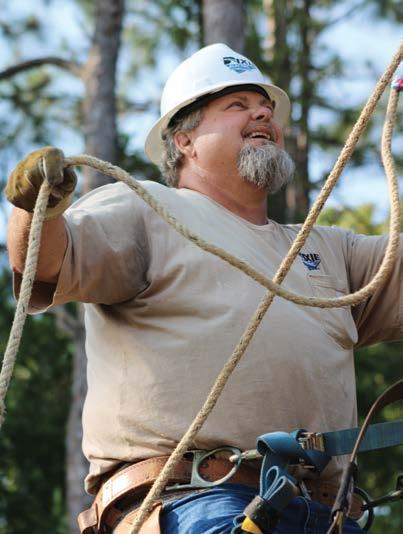
by Amanda Mills
















With heavy hearts, the Dixie Electric family mourns the passing of our dear friend and colleague, Petal Line Foreman Bobby McDonald, who passed away on May 23. Bobby was a dedicated employee, a steady leader, and above all, a kind and genuine man who touched the lives of everyone he met.
Bobby began his career at Dixie Electric in 1998 as a serviceman. Through hard work, humility, and dedication, he was promoted to Line Foreman in March 2012. Over the years, Bobby quietly led by example — exuding kindness, showing unwavering dependability, and demonstrating deep knowledge in his field. He was not only a skilled lineman but also a patient and gifted teacher, always ready to lend a hand or share his wisdom with those coming up behind him.
In every role he held, Bobby exuded the qualities we value most — kindness, dependability, and integrity. He was known for his warm smile, contagious laugh, and unwavering willingness to do whatever was asked of him. Petal District Supervisor Jerry Gibson said it best: “You’d be hard-pressed to find anyone who didn’t like Bobby. He was just that kind of person.”
“Bobby was a good man,” said General Manager Randy Smith. “He was quiet and humble and always willing to do whatever was
asked of him. He always wore a big smile. He was always the first one to the o ce every morning, had the co ee made, and was getting the day’s work ready. He was old school in the way that he approached his job. Bobby was a good leader and teacher for the guys who came up under him. We are going to miss him tremendously.”
To know Bobby was to know a man of quiet strength. His impact at Dixie Electric went far beyond the job's daily tasks — he built lasting friendships, created a positive work environment, and embodied what it means to be part of a team. His influence will be felt for years to come, both in the work he did and in the hearts of those he worked alongside.
Outside of work, Bobby was a loving husband and father. He was deeply devoted to his family, and our thoughts and prayers are with them as they grieve this tremendous loss.
There truly aren’t enough words to capture what Bobby meant to us. He was more than a coworker — he was family. He will be deeply missed, fondly remembered, and always honored.











18 AUG



Held at Dixie Electric’s office, 1863 Highway 184, Laurel, MS 39443.
Online voting begins. Make sure Dixie Electric has your valid email address, so you can vote online or use the SmartHub app.


Registration and voting begin at 10 a.m. The meeting begins at 11 a.m.



Electronic and mail voting ends.
4 SEP Official notice, absentee ballot, and proxy are mailed to members. Return your ballot or proxy in the postage-paid envelope.

Join
for the annual meeting and vote in person.



















DeKalb 601-743-2641 • Louisville 662-773-5741 • Quitman 601-776-6271







• Meridian / After-Hours Outages 601-581-8600
MEMBER OWNED. LOCALLY OPERATED. THAT’S THE COOPERATIVE DIFFERENCE.




As we mark the fifth anniversary of East Mississippi Connect (EMC), we reflect on an extraordinary journey — one defined by vision, perseverance, and a deep commitment to the communities we serve. This milestone is more than a marker in time; it’s a celebration of meaningful progress and the bright future ahead for both EMC and East Mississippi Electric Power Association (EMEPA).
EMC began with a bold yet simple mission: to deliver highspeed broadband to rural communities that had long been underserved. That vision quickly took root, transforming into a thriving reality that continues to bridge digital divides across east Mississippi.
The road wasn’t without challenges, but our mission remained steady. Guided by the core values of integrity, accountability and excellence, every decision was grounded in our commitment to serve. Our Board of Directors played a critical role, providing the leadership and support that propelled us forward.
In just five years, EMC has achieved milestones once considered distant goals:
• More than 3,860 miles of fiber completed in just 36 months
• Over 15,750 members now connected
• Strong partnerships that enhance our reach and impact
• Reliable, high-quality service at a valued price
These accomplishments are more than statistics — they reflect changed lives, new opportunities and stronger communities. The voices of our members, sharing their satisfaction and trust, remain the most powerful testament to our success.

Our team — past and present — has been the driving force behind our achievements. With a shared commitment to excellence and a “get it done” mindset, they’ve turned dreams into deliverables and goals into realities. We’re proud of the culture we’ve built — rooted in service, integrity and hard work.
Our success belongs to our members and the communities we serve. Your support and belief in our mission have fueled our progress. Through donations, volunteer e orts and local initiatives, we remain committed to giving back and building stronger, more connected communities.
As we celebrate this milestone, we also look to the future with excitement. With a strong foundation and a clear vision, we’re poised to continue innovating, expanding and strengthening the connections that matter most.
To our employees, members, board and community partners — thank you for your trust and support. Here’s to the next five years of growth, service and shared success.

by Randy Carroll
CEO — East Mississippi Electric Power Association
Our employees will observe Independence Day, and our o ces will be closed Friday, July 4, for the holiday.

O cial Annual Meeting notices and proxy letters were mailed to all EMEPA Members on June 30. If you cannot attend the meeting on Saturday, Oct. 4, you can appoint the Board of Directors or any other member as your proxy. This year, there are two ways to return your completed proxy:


OPTION 1: Complete your proxy online at directvote.net/EMEPA using your Member Number and Election Passcode printed on the proxy letter. Follow the prompts to complete your proxy. Online voting ends at 5 p.m. on Tuesday, Sept. 30. For assistance, email support@directvote.net.
One member from each EMEPA district will win a $500 electricity credit through a random drawing of those who return a completed proxy, either online or by mail. Members attending the meeting will be eligible to win one of three credits up to $500 by registering at the meeting on Oct. 4.
For questions, email ContactUs@EMEPA.com.


SATURDAY, OCT. 4, 2025
OPTION 2: Sign and date the proxy letter, seal it in the provided postage-paid envelope, and mail it. Proxies must be received by Tuesday, Sept. 30. EMEPA




The Electric Cooperatives of Mississippi Foundation provides scholarships to the children of Mississippi cooperative employees that are qualifying high school seniors enrolled full time at accredited institutions for the following fall semester. Additionally, Electric Cooperatives of Mississippi Foundation Transfer Scholarships are available to the children of Mississippi cooperative employees who attended a community college or vocational school and transfer to a university to continue their education.
2025 Electric Cooperatives of Mississippi Foundation Scholarship recipients: Neanna Drake, daughter of Member Service Representative Hynesia Cole-Drake Charlie Carmichael, son of Fiber Operations Manager Jamey Farmer Hunter Steakley, son of Lineman Josh Steakley Heidi Ainsworth, daughter of Journeyman Lineman Bobby Ainsworth (not pictured)
2025 Electric Cooperatives of Mississippi Foundation Transfer Scholarship recipient: Samiya Lewis, daughter of Member Services Representative Ereca Randle (not pictured)
Neanna Drake, of Kemper County High School, was awarded a $4,000 college scholarship from the Tennessee Valley Authority (TVA).
TVA’s Power PLAY Scholarship Association rewards students for academic and community service excellence. Through this scholarship program, TVA and East Mississippi Electric Power Association aim to support its recipients in becoming tomorrow’s guiding light by investing their time and talent in community development, personal growth and team accomplishments.
TVA and distributors of TVA power created the scholarship program in 1995 for the children of distributors’ employees to encourage students to excel and to recognize the strength of the partnerships between TVA and its distributors.
Scholarship recipients are selected by a panel of college professors from across the Tennessee Valley.













How do I improve the e ciency of my older home while keeping its charm?

by Miranda Boutelle
Start by prioritizing the invisible upgrades that make your home more comfortable and e cient. When we were kids, I don’t think any of us thought, “When I grow up, I want to spend my hard-earned money on insulation.” It’s not as exciting as new countertops or a remodeled bathroom, but air sealing and insulation can save you money every month. Then you can apply the savings to aesthetic improvements.
Many older homes are not properly insulated. Insulation has several benefits beyond sealing your home and keeping outdoor air from seeping in. It reduces outdoor noise, makes your home quieter and improves your overall comfort.
Always properly air seal before you insulate. Older homes with pocket doors, coved ceilings, dumbwaiters, doors to attic spaces, and laundry chutes allow indoor air to escape through the cavities, gaps and cracks around these classic features. Sealing o open cavities around those features often requires plywood, rigid foam, or drywall fastened into place and then caulked around the edges.
Keep an eye out for framing features that cause drafts. Balloon framing is a type of construction where wall studs run all the way from the foundation to the roof, allowing air to flow freely through those spaces. Second floors with knee wall attics on both sides are notorious for air leakage. Open cavities allow air to flow horizontally between the attic spaces, making the home uncomfortable and ine cient. Seal o the open cavities in the floor framing and insulate attic spaces.
Dense-packed cellulose or closed cell foam insulation can be sprayed into exterior walls. Skilled contractors can remove pieces of siding and drill holes to fill the wall cavities from the outside of the home. For brick or stone homes, holes can be drilled from the inside and then patched and painted. Insulating walls from the inside of the home requires more time and e ort in preparation and cleanup, but having well-insulated walls is worth it.
Knob and tube wiring — commonly used from the early 1880s to the 1930s with no grounding wire — should be replaced prior to insulating walls and attics for safety purposes. Contact between insulation and knob and tube wiring can create a fire hazard.
People often think new windows are the best way to improve a home’s e ciency. Considering the cost of replacing windows,



AI love old homes. The details and craftsmanship have always drawn me to them. The features of older homes can make them less e cient than modern construction, but it doesn’t have to be that way. You can keep the charm and make your home more e cient.

I recommend investing in air sealing and insulation first. Then consider storm windows to keep the charm of the original windows, such as leaded glass and stained-glass windows in good condition. Choose from interior or exterior options that are operable and inoperable.

Prioritize the invisible upgrades that make your home more comfortable and e cient, such as adding blown-in insulation to your attic. Photo Credit: Bonneville Power Administration
Once you’ve addressed the envelope of your home, consider appliance improvements. Replace your old electric water heater with a heat pump water heater. This upgrade can save a family of four an estimated $550 per year and more than $5,600 over the lifetime of the water heater, according to ENERGY STAR®. Invest in high-e ciency heating and cooling equipment. A mini-split heat pump, also known as a ductless heat pump, is a more e cient option than electric baseboard heating and provides the benefit of air conditioning.
Older homes don’t have to be ine cient. Show your home some love and invest in energy e cient upgrades.
Miranda Boutelle is the chief operating o cer at E ciency Services Group in Oregon, a cooperatively owned energy e ciency company.
As a new school year approaches, East Mississippi Connect—a subsidiary of East Mississippi Electric Power Association—is doing more than delivering high-speed fiber internet. It’s helping shape the future of education in rural East Mississippi by ensuring students, parents and educators have the tools they need for a successful academic year.
In an increasingly digital world, reliable internet is no longer a luxury—it’s a necessity. EMC’s broadband services are bridging the digital divide in underserved communities by providing a ordable, high-speed fiber access to thousands of homes. This technology has become essential for students completing homework, attending virtual classes or participating in hybrid learning environments.
The EMC Wi-Fi App adds another layer of support for families, giving parents full control over their home networks. With features like parental controls, content filtering, usage monitoring and guest Wi-Fi access, it allows households to manage screen time, encourage focus during study hours and ensure a safer online experience for children.
“We believe every student deserves a strong foundation—both in the classroom and at home,” says Randy Carroll, CEO and general manager of both EMEPA and EMC. “By expanding broadband access and providing tools that support safe online learning, we’re investing in the future of our communities.”
academic resources without disruption. This continuity is key in improving student outcomes, retention rates and overall academic performance.
As families begin preparing for the fall semester, EMC encourages parents to take proactive steps for a smooth transition:
Back-to-School Tips for a Connected Year:
• Test Your Tech: Make sure your home internet is up to speed and devices are updated and functioning properly.
• Set Digital Boundaries: Use EMC’s parental control tools to schedule downtime and reduce distractions during study hours.
• Create a Routine: Start reestablishing bedtimes and homework schedules at least two weeks before school starts.
• Designate a Study Zone: Create a dedicated, organized and distraction-free workspace for school tasks.
• Stay Connected with Schools: Use online portals, school newsletters and EMC’s network tools to stay ahead of important announcements.
By combining advanced technology with communitydriven values, East Mississippi Connect is helping pave the way for a more equitable and connected educational experience across the region.























































EMC is also aligned with statewide education initiatives like Mississippi Connects, working to make sure every student has access to devices, digital textbooks and consistent connectivity at home. This is especially important in households with multiple children who require simultaneous online access for schoolwork and virtual learning.



















































































































































































Higher education institutions, like East Mississippi Community College, are also reaping the benefits of EMC’s reliable service. With robust internet access, EMCC students are better equipped to access course materials, submit assignments and engage with To learn more about EMC’s home internet services and educational tools, visit











































voting members (“Members”) have the right to use, distribute, publicly display in any media whatsoever (“Use”) any graphic contained in the Straight T omoting their business. Members are permitted to modify Graphics for the purpose of incorporating their spective names and logos within a Graphic. Members ar permitted to size or alter the layout of a Graphic to fit the dimensional needs of a particular publication; howeve Members shall neither crop nor edit the Graphics as to substantially change or modify the original design





Members are not permitted to Use only portions of a Graphic. Members also may not sub-license, sell, lease, or r d parties. Members must include any attribution or source language if any is contained in the original file.

If you have a questions pertaining to this Policy, please contact Abby Berry at abby.berry@nreca.coop or 571-319-6231.





Electric Co-op Owned Equipment vs Member-Owned Equipment





graphic depicts equipment owned by the co-op (in gold) and the member (in blue). storm damages any equipment owned by the co-op, we are responsible for pairs. If a storm damages any member-owned equipment, the member is sponsible for repairs. Members should hire a licensed electrician making any repairs to member-owned equipment.
As July rolls in with longer days and rising temperatures, it also brings the increased potential for severe weather. Summer storms can arrive quickly and hit hard, sometimes causing significant damage to essential electric equipment throughout our community.
Magnolia Electric is always prepared to respond swiftly to outages and restore power safely, but it is also important for homeowners to understand which parts of the electric system are their responsibility and which are maintained by us at the co-op. Understanding these key di erences can help speed up repairs and ensure everyone stays safe when the weather turns rough.
Magnolia Electric is responsible for maintaining and repairing the equipment and lines that run to your home, including utility poles, distribution power lines, electric meters, and padmounted transformers.
Magnolia Electric members are responsible for the equipment located between the electric meter and your home or business. Members are also responsible for the weatherhead and service mast located outside the home.
If any equipment that you (the homeowner) are responsible for is damaged, please call a licensed electrician to conduct the repairs. A professional has the experience and know-how to assess and manage these types of repairs.
When severe weather damages electrical equipment, it’s important to note that any necessary repairs to the homeowner’s equipment must be conducted before Magnolia Electric crews can restore power to your home or business. By understanding the equipment you are responsible for, the repair and restoration process will be smoother and faster.
Our community takes great pride in the beautiful trees and landscaping that contribute to the natural beauty where we live, however, regular trimming is essential to ensure reliable electric service and minimize damage from severe weather. Magnolia Electric regularly trims trees throughout our service territory to improve service reliability. If you spot a tree limb that is obstructing a distribution power line outside your home, please call Magnolia Electric.
Any overgrown limbs or vegetation around the service line is trimmed by request only and any cleanup is the responsibility of the MEP member. If there is any structure or property that could be damaged by the trimming, a professional tree service would need to be called. By working together to understand the essential equipment that powers daily life, we can all be better prepared to start the repair and restoration process if severe weather impacts our community.






by Darrell Smith
CEO/General Manager





























































by Scott Flood
Don’t generate problems with your backup generator.
The wind howls outside your windows as a major storm system blows through the area in the late evening. Your lights flicker for a moment or two before you’re plunged into darkness.
Fortunately, you had the foresight to buy a backup generator big enough to handle your refrigerator, freezer, and other key needs.
Mississippi’s electric cooperatives understand power outages are a major inconvenience, and we do our best to prevent them. But when severe weather rolls through, outages can sometimes stretch into several hours or even days after a major storm. Lineworkers may have to check many miles of power lines to pinpoint the problems before they can begin their work to restore service. That’s why many co-op members consider buying backup generators to provide for their family’s needs while waiting for service to resume.
Backup generators fall into one of two categories. Standby generators are permanently wired into the home’s electrical system by a qualified electrician. Portable generators, as the name implies, can be moved to wherever they are needed. Because they’re small enough to move, they generally provide less power than standby models.
Some homeowners make the mistake of plugging their backup generators directly into a wall outlet or connect them to their home’s electrical panel. Beyond the significant risk of electrocution and fire that can create, plugging generators directly into your outlets can send the voltage your generator creates into the power lines connecting your home to the electric grid. That creates a dangerous condition called “backfeed,” which can seriously injure the lineworkers who are working so hard to restore your electricity, as well as anyone who accidentally comes in contact with power lines.
That’s why permanently installed backup generators are required to have what’s known as a transfer switch, which should be installed by a qualified electrician. The transfer switch creates a barrier between your home’s electrical system and the outside wires, so backfeed cannot occur. When the transfer switch senses that power has been restored, it switches the power from the generator back to the outside lines.
The biggest danger associated with backup generators is one that’s both invisible, odorless, and deadly. Because backup generators burn fossil fuels, they generate a variety of gases, most notably carbon monoxide. The agency reports that nearly 100 Americans lose their lives each year because of CO poisoning from backup generators. That’s why generators should only be used in dry, well-ventilated areas away from your home and garage.




CO has the potential to kill in as little as five minutes. People exposed to CO typically become dizzy, feel nauseated, and experience headaches. Often, they lose consciousness before noticing any symptoms. Anyone exposed to CO should be moved to fresh air immediately.
If you purchase a portable backup generator, protect your home and family by taking the time to read the manufacturer’s instructions. Don’t use portable generators in rainy or wet conditions unless you keep them shielded from moisture and well-ventilated.
When starting a portable generator, make sure nothing is plugged into it. In addition, you can reduce the potential for damage to your appliances and lighting by turning them o or unplugging them from the wall. After the generator starts, plug them in and turn them on one at a time to make sure you aren’t overloading your generator’s capacity. Unplug them from the generator before turning it o . Unless the manufacturer recommends otherwise, always turn the generator o and allow it to cool before adding fuel.
Finally, as with many home appliances, regular maintenance is the key to ensuring your portable generator operates safely for years to come.
For more than four decades, business writer Scott Flood has worked with electric cooperatives to build knowledge of energy-related issues among directors, sta and members.













How do I improve the e ciency of my older home while keeping its charm?

by Miranda Boutelle
Start by prioritizing the invisible upgrades that make your home more comfortable and e cient. When we were kids, I don’t think any of us thought, “When I grow up, I want to spend my hard-earned money on insulation.” It’s not as exciting as new countertops or a remodeled bathroom, but air sealing and insulation can save you money every month. Then you can apply the savings to aesthetic improvements.
Many older homes are not properly insulated. Insulation has several benefits beyond sealing your home and keeping outdoor air from seeping in. It reduces outdoor noise, makes your home quieter and improves your overall comfort.
Always properly air seal before you insulate. Older homes with pocket doors, coved ceilings, dumbwaiters, doors to attic spaces, and laundry chutes allow indoor air to escape through the cavities, gaps and cracks around these classic features. Sealing o open cavities around those features often requires plywood, rigid foam, or drywall fastened into place and then caulked around the edges.
Keep an eye out for framing features that cause drafts. Balloon framing is a type of construction where wall studs run all the way from the foundation to the roof, allowing air to flow freely through those spaces. Second floors with knee wall attics on both sides are notorious for air leakage. Open cavities allow air to flow horizontally between the attic spaces, making the home uncomfortable and ine cient. Seal o the open cavities in the floor framing and insulate attic spaces.
Dense-packed cellulose or closed cell foam insulation can be sprayed into exterior walls. Skilled contractors can remove pieces of siding and drill holes to fill the wall cavities from the outside of the home. For brick or stone homes, holes can be drilled from the inside and then patched and painted. Insulating walls from the inside of the home requires more time and e ort in preparation and cleanup, but having well-insulated walls is worth it.
Knob and tube wiring — commonly used from the early 1880s to the 1930s with no grounding wire — should be replaced prior to insulating walls and attics for safety purposes. Contact between insulation and knob and tube wiring can create a fire hazard.
People often think new windows are the best way to improve a home’s e ciency. Considering the cost of replacing windows,



AI love old homes. The details and craftsmanship have always drawn me to them. The features of older homes can make them less e cient than modern construction, but it doesn’t have to be that way. You can keep the charm and make your home more e cient.

I recommend investing in air sealing and insulation first. Then consider storm windows to keep the charm of the original windows, such as leaded glass and stained-glass windows in good condition. Choose from interior or exterior options that are operable and inoperable.

Prioritize the invisible upgrades that make your home more comfortable and e cient, such as adding blown-in insulation to your attic. Photo Credit: Bonneville Power Administration
Once you’ve addressed the envelope of your home, consider appliance improvements. Replace your old electric water heater with a heat pump water heater. This upgrade can save a family of four an estimated $550 per year and more than $5,600 over the lifetime of the water heater, according to ENERGY STAR®. Invest in high-e ciency heating and cooling equipment. A mini-split heat pump, also known as a ductless heat pump, is a more e cient option than electric baseboard heating and provides the benefit of air conditioning.
Older homes don’t have to be ine cient. Show your home some love and invest in energy e cient upgrades.
Miranda Boutelle is the chief operating o cer at E ciency Services Group in Oregon, a cooperatively owned energy e ciency company.





















voting members (“Members”) have the right to use, distribute, publicly display in any media whatsoever (“Use”) any graphic contained in the Straight T (“Graphics”) for the purpose of promoting their business. Members ar for the purpose of incorporating their respective names and logos within a Graphic. Members ar permitted to size or alter the layout of a Graphic to fit the dimensional needs of a particular publication; howeve Members shall neither crop nor edit the Graphics as to substantially change or




AMORY – P.O. BOX 300 - 50408 GREENBRIAR ROAD – 662-256-2962 • CALEDONIA – 746 MAIN STREET – 662-356-4100

Members are not permitted to Use only portions of a Graphic. Members also may not sub-license, sell, lease, or rent Graphics to third parties. Members must include any attribution or source language if any is contained in the original file.




Co-op Owned Equipment vs Member-Owned Equipment

equipment owned by the co-op (in gold) and the member (in blue). any equipment owned by the co-op, we are responsible for damages any member-owned equipment, the member is pairs. Members should hire a licensed electrician epairs to member-owned equipment.


As July rolls in with longer days and rising temperatures, it also brings the increased potential for severe weather. Summer storms can arrive quickly and hit hard, sometimes causing significant damage to essential electric equipment throughout our community.
Monroe County Electric is always prepared to respond swiftly to outages and restore power safely, but it is also important for homeowners to understand which parts of the electric system are their responsibility and which are maintained by us at the co-op. Understanding these key di erences can help speed up repairs and ensure everyone stays safe when the weather turns rough.
Monroe County Electric is responsible for maintaining and repairing the equipment and lines that run to your home, including utility poles, distribution power lines, electric meters, and padmounted transformers.
Monroe County Electric members are responsible for the equipment located between the electric meter and your home or business. Members are also responsible for the weatherhead and service mast located outside the home.
If any equipment that you (the homeowner) are responsible for is damaged, please call a licensed electrician to conduct the repairs. A professional has the experience and know-how to assess and manage these types of repairs.
When severe weather damages electrical equipment, it’s important to note that any necessary repairs to the homeowner’s equipment must be conducted before Monroe County Electric crews can restore power to your home or business. By understanding the equipment you are responsible for, the repair and restoration process will be smoother and faster.
Our community takes great pride in the beautiful trees and landscaping that contribute to the natural beauty where we live, however, regular trimming is essential to ensure reliable electric service and minimize damage from severe weather. Monroe County Electric regularly trims trees throughout our service territory to improve service reliability. If you spot a tree limb that is obstructing a distribution power line outside your home, please call Monroe County Electric, so we can trim those limbs and maintain those lines.
Any overgrown limbs or vegetation around the service line is the homeowner’s responsibility, and in these cases, please call a professional tree trimming service to assist.
By working together to understand the essential equipment that powers daily life, we can all be better prepared to start the repair and restoration process if severe weather impacts our community.
If you have a questions pertaining to this Polic please contact Abby Berry at abby ca.coop or 571-319-6231.







This graphic depicts equipment owned by the co-op (in gold) and the member (in blue). If a storm damages any equipment owned by the co-op, we are responsible for repairs.













by Scott Flood
Don’t generate problems with your backup generator.
The wind howls outside your windows as a major storm system blows through the area in the late evening. Your lights flicker for a moment or two before you’re plunged into darkness. The social media feed on your phone is packed with reports of damage and power outages, and the storm shows no sign of letting up for hours.
Fortunately, you had the foresight to buy a backup generator big enough to handle your refrigerator, freezer and other key needs. Flashlight in hand, you attach extension cords. Within minutes, you hear the quiet humming that tells you they’re working again.
Mississippi’s electric cooperatives understand power outages are a major inconvenience, and we do our best to prevent them. But when severe weather rolls through, outages can sometimes stretch into several hours or even days after a major storm. Lineworkers may have to check many miles of power lines to pinpoint the problems before they can begin their work to restore service. That’s why many co-op members consider buying backup generators to provide for their family’s needs while waiting for service to resume.
The biggest danger associated with backup generators is one that’s both invisible and deadly. Because backup generators burn fossil fuels, they generate a variety of gases, most notably carbon monoxide.


Backup generators fall into one of two categories. Standby generators are permanently wired into the home’s electrical system by a qualified electrician. They come in a variety of sizes, so homeowners can match the generator to their home’s power needs. Portable generators, as the name implies, can be moved to wherever they are needed. Because they’re small enough to move, they generally provide less power than standby models. Most use gasoline or diesel fuel, and when they’re operated correctly, both types provide a safe source of backup power.
Some homeowners make the mistake of plugging their backup generators directly into a wall outlet or connect them to their home’s electrical panel. Beyond the significant risk of electrocution and fire that can create, plugging generators directly into your outlets can send the voltage your generator creates into the power lines connecting your home to the electric grid. That creates a dangerous condition called “backfeed,” which can seriously injure the lineworkers who are working so hard to restore your electricity, as well as anyone who accidentally comes in contact with power lines. Backfeed can also damage the generator.
That’s why permanently installed backup generators are required to have what’s known as a transfer switch, which should be installed by a qualified electrician. The transfer switch creates a barrier between your home’s electrical system and the outside wires, so backfeed cannot occur. When the transfer switch senses that power has been restored, it switches the power from the generator back to the outside lines.
The biggest danger associated with backup generators is one that’s both invisible and deadly. Because backup generators burn fossil fuels, they generate a variety of gases, most notably carbon monoxide. According to the Consumer Product Safety Commission, one portable generator can produce as much CO as hundreds of cars. The agency reports that nearly 100 Americans lose their lives each year because of CO poisoning from backup generators. That’s why generators should only be used in dry, well-ventilated areas away from your home and garage.
CO gas is not only invisible, but it’s also odorless. The National Institutes of Health warns that CO has the potential to kill in as little as five minutes. People exposed to CO typically become dizzy, feel nauseated, and experience headaches. Often, they lose consciousness before noticing any symptoms. Anyone exposed to CO should be moved to fresh air immediately.
If you purchase a portable backup generator, protect your home and family by taking the time to read the manufacturer’s instructions. Don’t use portable generators in rainy or wet conditions unless you keep them shielded from moisture and well-ventilated.
When starting a portable generator, make sure nothing is plugged into it. In addition, you can reduce the potential for damage to your appliances and lighting by turning them o or unplugging them from the wall. After the generator starts, plug them in and turn them on one at a time to make sure you aren’t overloading your generator’s capacity. Unplug them from the generator before turning it o . Unless the manufacturer recommends otherwise, always turn the generator o and allow it to cool before adding fuel.


Finally, as with many home appliances, regular maintenance is the key to ensuring your portable generator operates safely for years to come. When storing it, drain the fuel from the tank. In addition, check the oil and fuel level, filters, and other components once a season so you know it will be ready to run safely and e ciently the next time a big storm blows through.
For more than four decades, business writer Scott Flood has worked with electric cooperatives to build knowledge of energy-related issues among directors, sta and members.
















QHow do I improve the e ciency of my older home while keeping its charm?

by Miranda Boutelle
Start by prioritizing the invisible upgrades that make your home more comfortable and e cient. When we were kids, I don’t think any of us thought, “When I grow up, I want to spend my hard-earned money on insulation.” It’s not as exciting as new countertops or a remodeled bathroom, but air sealing and insulation can save you money every month. Then you can apply the savings to aesthetic improvements.
Many older homes are not properly insulated. Insulation has several benefits beyond sealing your home and keeping outdoor air from seeping in. It reduces outdoor noise, makes your home quieter and improves your overall comfort.
Always properly air seal before you insulate. Older homes with pocket doors, coved ceilings, dumbwaiters, doors to attic spaces, and laundry chutes allow indoor air to escape through the cavities, gaps and cracks around these classic features. Sealing o open cavities around those features often requires plywood, rigid foam, or drywall fastened into place and then caulked around the edges.
Keep an eye out for framing features that cause drafts. Balloon framing is a type of construction where wall studs run all the way from the foundation to the roof, allowing air to flow freely through those spaces. Second floors with knee wall attics on both sides are notorious for air leakage. Open cavities allow air to flow horizontally between the attic spaces, making the home uncomfortable and ine cient. Seal o the open cavities in the floor framing and insulate attic spaces.
Dense-packed cellulose or closed cell foam insulation can be sprayed into exterior walls. Skilled contractors can remove pieces of siding and drill holes to fill the wall cavities from the outside of the home. For brick or stone homes, holes can be drilled from the inside and then patched and painted. Insulating walls from the inside of the home requires more time and e ort in preparation and cleanup, but having well-insulated walls is worth it.
Knob and tube wiring — commonly used from the early 1880s to the 1930s with no grounding wire — should be replaced prior to insulating walls and attics for safety purposes. Contact between insulation and knob and tube wiring can create a fire hazard.
People often think new windows are the best way to improve a home’s e ciency. Considering the cost of replacing windows,


AI love old homes. The details and craftsmanship have always drawn me to them. The features of older homes can make them less e cient than modern construction, but it doesn’t have to be that way. You can keep the charm and make your home more e cient.

I recommend investing in air sealing and insulation first. Then consider storm windows to keep the charm of the original windows, such as leaded glass and stained-glass windows in good condition. Choose from interior or exterior options that are operable and inoperable.

Prioritize the invisible upgrades that make your home more comfortable and e cient, such as adding blown-in insulation to your attic. Photo Credit: Bonneville Power Administration
Once you’ve addressed the envelope of your home, consider appliance improvements. Replace your old electric water heater with a heat pump water heater. This upgrade can save a family of four an estimated $550 per year and more than $5,600 over the lifetime of the water heater, according to ENERGY STAR®. Invest in high-e ciency heating and cooling equipment. A mini-split heat pump, also known as a ductless heat pump, is a more e cient option than electric baseboard heating and provides the benefit of air conditioning.
Older homes don’t have to be ine cient. Show your home some love and invest in energy e cient upgrades.
Miranda Boutelle is the chief operating o cer at E ciency Services Group in Oregon, a cooperatively owned energy e ciency company.












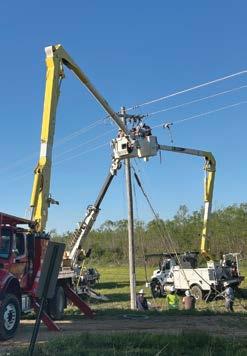










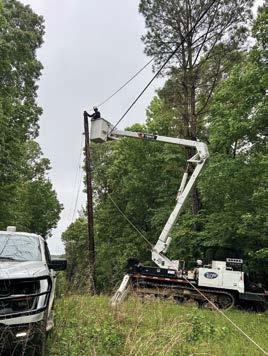

This spring brought a series of five powerful storms to our area. At North East Mississippi Electric Power Association, our commitment to reliable service was front and center as we worked around the clock to restore power to our members as quickly and safely as possible.
Strong straight-line winds, torrential rain, and a tornado caused widespread outages throughout our service territory. Our linemen and support sta worked tirelessly in di cult conditions — through fallen trees, downed lines, and challenging terrain — to bring the lights back on for every member we serve.
“This spring brought heavy rainfall and severe weather that caused large trees to fall, resulting in broken poles and downed power lines across our service area. Our dedicated crews worked tirelessly — often in di cult and dangerous conditions — to restore power as safely and quickly as possible,” said Keith Hayward, CEO/general manager, North
East Power. “We’re grateful for the patience and support of our members throughout each restoration e ort.”
We are especially grateful to our members for their patience and understanding during these trying times. We know how disruptive losing power can be, and your support meant the world to us as we worked through each restoration e ort.
In a few of the hardest-hit storms, we were fortunate to receive mutual aid from neighboring cooperatives. Crews from Tombigbee Electric Power Association, Northcentral Electric Cooperative, and Tallahatchie Valley Electric Power Association stepped in to lend a hand. Their help made a tremendous di erence, and we are deeply thankful for their partnership and support. This kind of cooperation is what makes the electric cooperative community so strong.
At North East Power, we’re proud to serve you — no matter what the forecast holds.
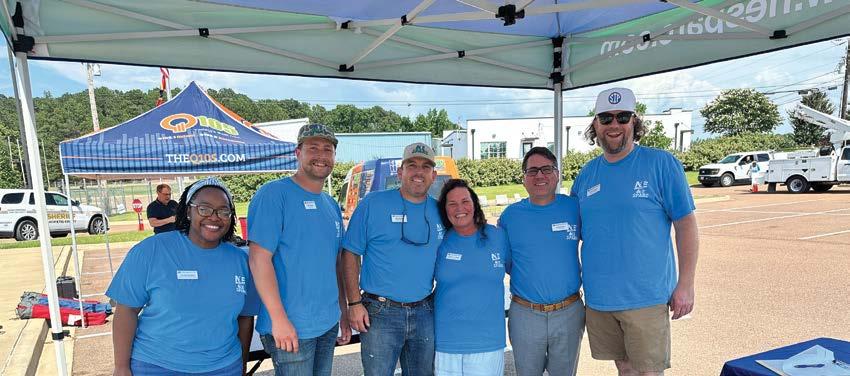


















































At North East Mississippi Electric Power Association, our members are at the heart of everything we do — and that’s why we were thrilled to celebrate them at our Member Appreciation Event on June 5. The event was a chance to say thank you to all the people we proudly serve.
Held at North East Power, the afternoon was filled with food, fellowship, and fun for all ages. Members enjoyed hot dogs and sno-cones, giveaways, and activities for kids. The North East Power and NE SPARC teams were on hand to answer questions, share updates about current projects, and connect with members.
“This was the first time we held an event like this at our o ce,” said Sarah Brooke Bishop, North East Power’s communications and marketing manager. “It was a great opportunity for us to show our gratitude to the people we serve.”
At North East Power, being a cooperative means more than keeping the lights on — it means being part of something bigger. The Member Appreciation Event was a small way to say thank you for the trust our members place in us every day.
















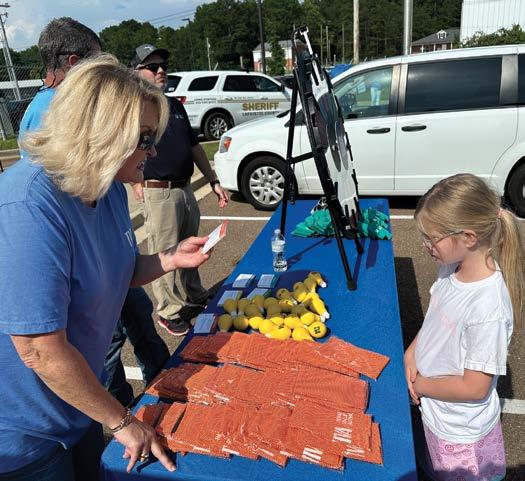























Like most people in today’s digital age, you probably spend a considerable portion of your life online. From daily emailing to online banking, managing finances, and shopping, these basics of everyday life are undoubtedly enhanced by our ever-present internet world. But with so much of our lives intertwined with the web, online security is more important than ever. And sadly, with cyber threats and data breaches on the rise, stepping up our personal cybersecurity is more crucial than ever.
A strong password is your first line of defense against unauthorized access to your accounts. Below are essential tips for creating a robust password for better online security. By utilizing a strong password, you can stay safer online while enjoying NE SPARC’s high-speed fiber internet for everything from streaming TV and movies to connecting with loved ones through video calling or managing your finances.
Many people have been using the same password for a long time — and across many apps and websites! And it’s common to use a word near and dear to one’s heart because it’s easier to remember.
This risky practice is not nearly secure enough to combat today’s sophisticated hackers and cybercriminals. A strong password typically includes a mix of the following characteristics:
• LENGTH: Aim for at least 12-16 characters. Longer passwords are generally more secure.
• COMPLEXITY: Use a diverse combination of uppercase letters, lowercase letters, numbers, and special symbols (e.g., &, !, @, and #).
• UNPREDICTABILITY: Avoid easily guessable information, such as names, birthdays, or common words.
Check out these examples of a weak (but common) password and a strong password:
• WEAK: Passcode123 (a shockingly overused word attached to a simple sequence of numbers is just not su cient in today’s world).
• STRONG: 6L~3s1yXt#f4Fmz8 (this tangled combo is loaded with randomness, making the password extremely di cult to guess).













If a jumbled set of letters, numbers, and characters is just too much to remember, you can still improve your password by lengthening it. A passphrase is a longer sequence of words or a sentence that’s easy for you to remember but di cult for others to guess.
For instance, instead of a single word, use a phrase like “MyCatMeows@Midnight?”
While seemingly silly, such a passphrase is more complex — and harder for hackers to guess or obtain — than using your cat’s name alone. And it’s also easy for you to remember.
It’s not enough just to make your passwords more secure — you need to keep them updated, too. Ideally, you should change your passwords periodically, with some experts recommending changing them about every three to six months. This is particularly wise for sensitive accounts like email and online banking or credit cards but should also be considered for your most commonly used apps and social media.
If a company, service, or app you use experiences a breach, you must change your password immediately, no matter how recently you last updated it. Additionally, if you notice any unusual activity in your accounts, change your password to give yourself peace of mind. Creating a strong password is a vital step in securing your online accounts. By following these tips, you can significantly enhance your password and your overall online security. And to learn more ways to stay safe online, check out NE SPARC’s social media pages for additional cybersecurity advice.
North East Mississippi Electric Power Association and NE SPARC have once again partnered for a grant program for local school teachers that facilitates innovative classroom-based education projects called Bright Ideas. Through Bright Ideas, teachers can illuminate students’ love of learning.
The Bright Ideas grant program aims to encourage, support, and celebrate creative educational experiences for the students and sta in our service area.
In 2024, teachers from the Oxford, Lafayette, Pontotoc, and West Union Schools were awarded Bright Ideas grants.
Local educators can apply for Bright Ideas grants of up to $500 for innovative, hands-on classroom projects. The grants are available to K-12 teachers in public schools that have at least one student who is a member of North East Power or NE SPARC customer. Projects can be in any subject, and educators can apply individually or as a team.
To apply, teachers must include a budget; explain the implementation, goals, creative elements and evaluation of the project; and have approval from their school’s principal. Applications will be blind judged through a competitive evaluation process, with judges looking for projects that feature inventive and creative approaches to learning.
Applications will be live on July 18 and available online at NEMEPA.org. The deadline to submit applications is Wednesday, Sept. 3, 2025. Teachers who submit their applications by the early bird deadline of Aug. 18, 2025, will be entered to win prizes that would benefit their classroom.
Our prize team will visit local schools in October to announce the winning grant recipients.



















The world lost a music icon when Sly Stone died earlier in June. Among my favorites was his hit, “Hot Fun in the Summertime”. Those days are definitely here as the trend of increasingly hot summers continue.
Take measures during this time of extreme heat to conserve energy when able. Be careful when spending time outside. While supply chain and high costs are a challenge, Northcentral will continue maintain our system in a manner to ensure reliability.
Reliability has and will continue to be the hot topic. Through Northcentral’s valued partnership with TVA, we have been able to handle the challenges of summer heat. Other challenges present themselves, however. Data centers, AI, and cryptocurrency mining are just part of an electrification trend we are seeing in the United States. New load growth is predicted to exceed 15% by 2030. This load growth must have new electricity generation resources to meet this demand. Our federal government has worked to remove some restrictions that hinder generation development but has also created new ones. Our federal administration has removed four






members of the TVA Board of Directors in the last three months. This places the board below a quorum and unable to vote on new generation projects. This makes it di cult for TVA to operate in an independent manner.
Northcentral and other electric cooperatives will work with our elected o cials to have qualified directors nominated and approved — directors who are knowledgeable as to the needs of the Valley and those in it. While seeing a dynamic explosion in electricity needs through technology and increased manufacturing, we can’t a ord to pump the brakes.
Stay safe.

by Kevin Doddridge General Manager/CEO












observe
Day, and our o ce will be closed Friday, July 4, for the
Northcentral Electric Cooperative is proud to announce that Jared Rumfelt, right-of-way coordinator, has completed the requirements of Leadership DeSoto. Jared was one of 27 others who graduated from the program on May 9 at Whispering Woods Conference Center.
Leadership DeSoto is coordinated by the DeSoto County Economic Development Council and gives participants a comprehensive look at the needs and challenges facing the county — while encouraging them to take an active role in its future.
Candidates are nominated by organizations, employers, or individuals and must complete a lengthy application process. A selection committee then chooses participants based on their community involvement, leadership capabilities, and potential in their respective fields.
Leadership DeSoto is a seven-month program that gives participants insight into community resources through sessions on leadership, economics, education, legislation, health care, local government, and community service.
Over the course of the program, Jared saw firsthand the diversity and complexity of DeSoto County — from its infrastructure and institutions to the very real needs of its underserved communities.
Program participants were placed into teams to work on projects that impact the county. Rumfelt and team partnered with the Olive Branch Food Pantry for their community service project. Though he had passed the pantry for years, he said he had never really noticed it until now. “Now I can’t drive past it without thinking about it and wondering what I can do to provide some type of service to them,” he said. The group volunteered their time, raised money, and held food drives to support the pantry and its mission.
Leadership DeSoto not only broadened Jared’s view of his community but also deepened his appreciation for the people in it. “There’s a lot of smart people; there’s a lot of good people; there’s a lot of people that are willing to go the extra mile to help those in need and serve their community,” he reflected.
When asked what leadership skill he’s taking with him from the experience, Rumfelt didn’t hesitate: “Compassion. This program brings out a personal element of serving and just being compassionate for others.”
At Northcentral, we’re proud to celebrate employees like Jared who embody our mission both on the job and out in the community.
If you would like more information on Leadership DeSoto, please visit desotocounty.com.










































































Donate July 9-31 for a chance to win a car. You could be the lucky donor randomly selected as the winner of up to $30,000 toward the purchase of your sweet, new ride!* Book your appointment today.
Make an appointment online or call 877-25-VITAL
Location: Auditorium
4600 Northcentral Way Olive Branch, MS 38654
Date: July 15, 2025
Time: 12pm - 4pm
Ever wonder how you can help a Mother, Cancer or Sickle Cell patient!
Donate today whole blood, red blood cells, plasma, platelets needed daily!
To schedule an appointment, visit donors.vitalant.org and use code: northcentralelectric or Use QR code
Don’t forget to bring a photo I D ~ eat well and drink plenty of water!
*Terms and condition apply; see vitalant.org/CarGiveaway









by Scott Flood
Don’t generate problems with your backup generator.
The wind howls outside your windows as a major storm system blows through the area in the late evening. Your lights flicker for a moment or two before you’re plunged into darkness.
Fortunately, you had the foresight to buy a backup generator big enough to handle your refrigerator, freezer, and other key needs.
Mississippi’s electric cooperatives understand power outages are a major inconvenience, and we do our best to prevent them. But when severe weather rolls through, outages can sometimes stretch into several hours or even days after a major storm. Lineworkers may have to check many miles of power lines to pinpoint the problems before they can begin their work to restore service. That’s why many co-op members consider buying backup generators to provide for their family’s needs while waiting for service to resume.
Backup generators fall into one of two categories. Standby generators are permanently wired into the home’s electrical system by a qualified electrician. Portable generators, as the name implies, can be moved to wherever they are needed. Because they’re small enough to move, they generally provide less power than standby models.
Some homeowners make the mistake of plugging their backup generators directly into a wall outlet or connect them to their home’s electrical panel. Beyond the significant risk of electrocution and fire that can create, plugging generators directly into your outlets can send the voltage your generator creates into the power lines connecting your home to the electric grid. That creates a dangerous condition called “backfeed,” which can seriously injure the lineworkers who are working so hard to restore your electricity, as well as anyone who accidentally comes in contact with power lines.
That’s why permanently installed backup generators are required to have what’s known as a transfer switch, which should be installed by a qualified electrician. The transfer switch creates a barrier between your home’s electrical system and the outside wires, so backfeed cannot occur. When the transfer switch senses that power has been restored, it switches the power from the generator back to the outside lines.
The biggest danger associated with backup generators is one that’s both invisible, odorless, and deadly. Because backup generators burn fossil fuels, they generate a variety of gases, most notably carbon monoxide. The agency reports that nearly 100 Americans lose their lives each year because of CO poisoning from backup generators. That’s why generators should only be used in dry, well-ventilated areas away from your home and garage.




CO has the potential to kill in as little as five minutes. People exposed to CO typically become dizzy, feel nauseated, and experience headaches. Often, they lose consciousness before noticing any symptoms. Anyone exposed to CO should be moved to fresh air immediately.
If you purchase a portable backup generator, protect your home and family by taking the time to read the manufacturer’s instructions. Don’t use portable generators in rainy or wet conditions unless you keep them shielded from moisture and well-ventilated.
When starting a portable generator, make sure nothing is plugged into it. In addition, you can reduce the potential for damage to your appliances and lighting by turning them o or unplugging them from the wall. After the generator starts, plug them in and turn them on one at a time to make sure you aren’t overloading your generator’s capacity. Unplug them from the generator before turning it o . Unless the manufacturer recommends otherwise, always turn the generator o and allow it to cool before adding fuel.
Finally, as with many home appliances, regular maintenance is the key to ensuring your portable generator operates safely for years to come.
For more than four decades, business writer Scott Flood has worked with electric cooperatives to build knowledge of energy-related issues among directors, sta and members.





























COLUMBIA: 601-736-2666 | HATTIESBURG: 601-264-2458 | PURVIS: 601-794-8051 | WIGGINS: 601-928-7277



















At Pearl River Valley Electric Power Association, we’re committed to helping our members stay comfortable during Mississippi’s hot summer months, without breaking the bank on energy bills. As temperatures rise, it’s more important than ever to use electricity wisely. By following a few simple tips and taking advantage of the resources we o er, you can stay cool during the height of summer.
One of the easiest ways to save is to set your thermostat at the highest temperature to meet your comfort level. Each degree you raise the temperature can save up to 3% on your cooling costs.
Also, keeping your AC unit in good shape is essential. Change your air filters regularly — ideally every month during high-use periods. A dirty filter makes your system work harder, which means more energy used and higher bills. Also, make sure your system’s fan is set to “auto” rather than “on” to avoid unnecessary use.
Ceiling fans can also make a big di erence. They don’t lower the temperature, but they help you feel cooler, letting you comfortably raise your thermostat setting. Just be sure to turn fans o when you leave the room to avoid wasting energy.
Simple home improvements can pay o big in energy savings. Sealing leaks around doors and windows and adding insulation in your attic help keep conditioned air inside where it belongs.
Window treatments also help. Close blinds or drapes during the heat of the day to block sunlight and reduce indoor temperatures. Every bit of shade can help your air conditioner work less.






Member owned. Locally operated. That’s the cooperative difference. • Visit us online at www.PRVEPA.com. PAY BILLS or REPORT OUTAGES: 855-2PRVEPA (855-277-8372)













Heat-producing appliances like ovens, clothes dryers, and dishwashers add unwanted warmth to your home. Try to use them early in the morning or after sundown, when it’s cooler. And whenever possible, wash clothes in cold water and air-dry instead of using a dryer.
At Pearl River Valley Electric, we’re proud to o er tools and programs designed to help our members take control of their energy use.
Our PRVEPA app and our EmPowered member portal at prvepa.com is a great way to monitor your electricity consumption and manage your account from your phone or computer. You can track energy use by the month, day or even by the hour to help identify patterns and opportunities for savings.
We also o er energy audits and personalized recommendations. If you’re not sure where to start, give us a call — we’ll be happy to help you find ways to save!

by Matthew Ware
CEO/General Manager










































One of our goals at Pearl River Valley Electric is to provide members with information about using energy wisely. When building or remodeling a home, energy e ciency should be a high priority. For more than 20 years our Comfort Advantage new home program has helped members save money on their monthly bills and increase the resale values of their homes.
Comfort Advantage energy-e ciency standards are based on years of experience, and they are continually being updated. The program now o ers the following incentives for new homes:
• Basic Comfort Advantage homes with a 14.3 SEER2 or a 15 SEER heat pump qualify for up to 150 feet of free underground service.
• Comfort Advantage Plus new homes with a 15.2 SEER2 or a 16 SEER heat pump qualify for up to 150 feet of free underground service and a rebate of $500.
• Geothermal heat pump installations qualify for an additional $500 rebate.
For existing homes, upgrading from older central electric heating/cooling systems or older ine cient heat pumps (10 Seer or less) to a 14.3 SEER2 or 15 SEER or higher heat pump qualifies for a $400 rebate.
Here are the complete requirements for the Comfort Advantage Program:





1. HEATING AND COOLING - Heat pump(s) rated at 14.3 SEER2 or 15 SEER or higher or a qualified geothermal heat pump(s). Flex duct work will be limited to runs of 8 feet or less. Ducts must be sealed with mastic and wrapped with R-6 or higher insulation.






Comfort Advantage Home (Basic) • Requirements for new construction

5. FLOOR INSULATION – Install insulation R-value of 19 or greater in floors over unconditioned areas or crawlspaces.


2. WATER HEATING - Electric tank water heater(s) with a .90 energy factor or higher. Include heat traps and insulate pipes. Outdoor gas tankless water heaters also qualify. Electric instantaneous water heaters do not qualify.


3. WALL INSULATION - Install insulation R-value of 13 or greater.


4. ATTIC INSULATION - Install insulation R-value of 38 or greater. (Exception: R-20 foam-encapsulated, semi-conditioned attic.)




















Comfort Advantage Plus-New Home additional upgrades for greater e ciency


6. WINDOWS - double pane windows with a U-value of .60 or less and a solar heat gain coe cient (SHGC) of .60 or less.


1. HEATING AND COOLING EQUIPMENT - heat pump(s) rated at 15.2 SEER2 or 16 SEER or higher; or a qualified geothermal heat pump. Upgrade to a programmable thermostat.

7. AIR SEALING - Air sealing must be applied to all penetrations through exterior walls and to holes into attics or crawlspaces. Apply sill insulation between the slab and bottom plate. Properly install housewrap or building paper to cover exterior sheathing in wood framed homes. Inside the home, apply appropriate caulk or gaskets to electrical boxes, and seal around plumbing penetrations.





2. WINDOWS - double pane windows with a U-value of .40 or less, and a SHGC rating of .35 or less.



For more information please contact us at 601-736-2666.















by Scott Flood
Don’t generate problems with your backup generator.
The wind howls outside your windows as a major storm system blows through the area in the late evening. Your lights flicker for a moment or two before you’re plunged into darkness.
Fortunately, you had the foresight to buy a backup generator big enough to handle your refrigerator, freezer, and other key needs.
Mississippi’s electric cooperatives understand power outages are a major inconvenience, and we do our best to prevent them. But when severe weather rolls through, outages can sometimes stretch into several hours or even days after a major storm. Lineworkers may have to check many miles of power lines to pinpoint the problems before they can begin their work to restore service. That’s why many co-op members consider buying backup generators to provide for their family’s needs while waiting for service to resume.
Backup generators fall into one of two categories. Standby generators are permanently wired into the home’s electrical system by a qualified electrician. Portable generators, as the name implies, can be moved to wherever they are needed. Because they’re small enough to move, they generally provide less power than standby models.
Some homeowners make the mistake of plugging their backup generators directly into a wall outlet or connect them to their home’s electrical panel. Beyond the significant risk of electrocution and fire that can create, plugging generators directly into your outlets can send the voltage your generator creates into the power lines connecting your home to the electric grid. That creates a dangerous condition called “backfeed,” which can seriously injure the lineworkers who are working so hard to restore your electricity, as well as anyone who accidentally comes in contact with power lines.
That’s why permanently installed backup generators are required to have what’s known as a transfer switch, which should be installed by a qualified electrician. The transfer switch creates a barrier between your home’s electrical system and the outside wires, so backfeed cannot occur. When the transfer switch senses that power has been restored, it switches the power from the generator back to the outside lines.
The biggest danger associated with backup generators is one that’s both invisible, odorless, and deadly. Because backup generators burn fossil fuels, they generate a variety of gases, most notably carbon monoxide. The agency reports that nearly 100 Americans lose their lives each year because of CO poisoning from backup generators. That’s why generators should only be used in dry, well-ventilated areas away from your home and garage.




CO has the potential to kill in as little as five minutes. People exposed to CO typically become dizzy, feel nauseated, and experience headaches. Often, they lose consciousness before noticing any symptoms. Anyone exposed to CO should be moved to fresh air immediately.
If you purchase a portable backup generator, protect your home and family by taking the time to read the manufacturer’s instructions. Don’t use portable generators in rainy or wet conditions unless you keep them shielded from moisture and well-ventilated.
When starting a portable generator, make sure nothing is plugged into it. In addition, you can reduce the potential for damage to your appliances and lighting by turning them o or unplugging them from the wall. After the generator starts, plug them in and turn them on one at a time to make sure you aren’t overloading your generator’s capacity. Unplug them from the generator before turning it o . Unless the manufacturer recommends otherwise, always turn the generator o and allow it to cool before adding fuel.
Finally, as with many home appliances, regular maintenance is the key to ensuring your portable generator operates safely for years to come.
For more than four decades, business writer Scott Flood has worked with electric cooperatives to build knowledge of energy-related issues among directors, sta and members.


PRVEPA was at Sumrall Elementary School’s egg drop at the end of the school year. Students created di erent contraptions to help their egg make it safely to the ground after being dropped from our bucket truck. Some eggs made it safely, others ended up scrambled.
PRVEPA also helped out with Oak Grove Elementary’s science day. Trey Ware showed students the dangers of electricity while detailing how electricity makes it from the generating plant to their homes. Thanks to all the schools for inviting us!
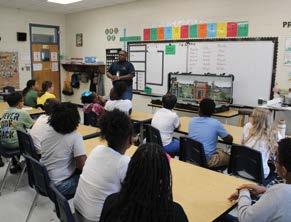

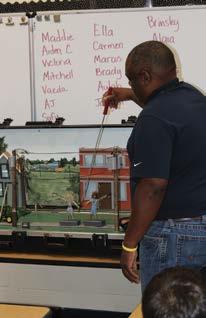




















































































































• Applications are available at PRVEPA o ces and at prvepa.com.
• Completed applications must be postmarked or emailed by Aug. 8.


• Scholarship recipients must be a PRVEPA member, spouse, or child of a member participating in the Round Up program.









• Recipients must be full time (12 hours or more per semester) freshmen students enrolled in academic or career-technical programs.
• Scholarship funds will be credited to each student’s college account — no checks will be issued to individuals.







• Scholarships should be awarded by the end of September. Students must be enrolled in good standing at the time funds are released to the colleges.






Funded by members who are rounding up their monthly bills, these scholarships are intended to assist students who will attend a Mississippi community college as a freshman this fall.
More information is available at prvepa.com.












































by Jennifer Johnson
The phone rings and you see a local number or a familiar one. The caller on the other end of the line tells you there has been a mistake with your power bill, and you’ve been overcharged. Your thoughts race – you could really use some extra money for medicine or food.
But wait – you could be dealing with a scammer. Some Pontotoc Electric members have received calls lately, stating the caller was from PEPA and needed the member’s bank account number to send a refund. That’s a red flag. In most cases, a utility will apply a credit to your account to cover future charges or refund an overpayment with a mailed check.
Make sure you never give out personal information. If you have any doubt, give us a call to discuss it.
Another thing to look out for is a fraudulent website pretending to be an electric utility. Scammers often create look-alike sites to steal your personal or payment information. Always type your utility’s official web address directly into your browser instead of clicking email or text links. Watch for signs of a secure website, such as “https://” in the address bar and a padlock icon.
Please be mindful of the information that is being asked for and don’t fall victim to a scam. PEPA General Manager Frankie Moorman said, “We want our members to know there are schemes out there to try to take their money. We don’t want that to happen to anyone. We want to remind our customers to be vigilant about these things.”
PEPA Manager of Customer Accounts Lavonia Lackey said, “Make sure you never give out personal information. If you have any doubt, give us a call to discuss it.”


by Jennifer Johnson
When it comes to learning new things, PEPA Member Felicia Pollard is like “the kid in the candy store.” It’s been part of her life since childhood. She remembers learning and playing board games with her grandmother. “We would sit for what seemed like hours playing games like Trouble, Sorry, or Parcheesi. She never let me win. I had to earn my win.”
She loved school, in part because of how much time she spent there with what she calls her extended family. “My mom was a teacher. School was a safe place for me. I knew the teachers. I roamed the halls in the summers. I always felt at home at school.”
After graduating from high school in 2001, Pollard continued learning. She got her undergraduate degree in elementary education at the University of Mississippi, then worked in the School of Education as a graduate assistant while earning her master’s degree in curriculum and instruction.
I want people to say they came to know Jesus more because they knew me. I hope I am remembered for my work ethic.
I hope people see me as someone who was a doer and as someone who enjoyed serving.
During her time at Ole Miss, Pollard met future husband Cullen. They were introduced in college by Pollard’s roommate during junior year but didn’t start dating until Pollard was in graduate school.
Pollard said when she was in high school she had a conversation with her mother about a certain kind of man that she wanted to marry. “I told my mom I was praying I met a supermodel who loved Jesus. When Cullen and I started dating, I told my mom he was too nice. We will be married 18 years this summer, and I’m more thankful each passing year that I chose the nice guy that loved Jesus.”
After college, Pollard worked for two years in the Tupelo Public School District and taught for three years at Pontotoc Elementary. Then, she entered the principal corps at Ole Miss to earn her
specialist degree in educational leadership. (The four levels of degree are bachelor’s, master’s, specialist, and doctorate. Pollard has all four. She’s also a National Board Certified Teacher.) After that, she took a job as a school administrator in the Lafayette County School District. A decade later, Pollard returned to Pontotoc to work in the district office at Pontotoc City Schools.
Pollard keeps busy. Between her job, community work, and raising a family – they have three boys: Jett, 12, Crosby, 7, and Berkley, almost 2. Pollard has a lot on her plate. She cherishes not just the big moments in their lives, but also those that have eternal significance. “We’ve had the opportunity to see our oldest accept Jesus and be baptized, and we eagerly await for our younger boys to do the same. Those kinds of sweeter moments are more meaningful in the grand scheme of life.”
Pollard finds enjoyment in painting and in making and decorating sugar cookies. She took up sewing about 20 years ago, and she said she comes back to it time and again. She studied to become a yoga teacher after the pandemic, and most recently, she learned to play and teach Majong, a game that originated in China in the 19th century. She credits mom Sarah Carter Brown, a retired teacher, with passing down the desire to be creative. “I grew up with an insanely talented mother, so her hobbies growing up are where I find comfort as I age.”
Pollard said she’s enjoying this chapter of her life but does have big plans for years down the road. “I’m beginning my 20th year in education, but with a child under 2, I know I will be in education for several more years. When I eventually retire, I know I won’t be a sit-at-home person.”
And one day when the road comes to an end? “I want people to say they came to know Jesus more because they knew me. I hope I am remembered for my work ethic. I hope people see me as someone who was a doer and as someone who enjoyed serving.”




CORRECTION – In the service anniversaries in the June 2025 issue of Today in Mississippi, Service Clerk Rhianna McClellan was recognized as having five years of service. Rhianna has 10 years of service. We apologize for the error.















Betty Armstrong, PEPA Retiree
1 package German chocolate cake mix
2 sticks margarine
1 box powdered sugar
4 eggs 8 ounces cream cheese, softened 1 teaspoon vanilla
Mix cake mix, 2 eggs, and 1 stick melted margarine. Press in a 9 x 13 pan. Cream 8 oz. cream cheese, 1 stick margarine, 2 eggs, and vanilla. Add to powdered sugar and put on top of cake mixture. Bake at 350 degrees until cake is set (40 -50 minutes or longer if needed.) Do not dry out.
Mary Williamson, Collection Manager
2 cups graham cracker crumbs
3 bananas, sliced
3 sticks oleo
1 large can pineapple, drained
2 eggs
1 large Cool Whip
2 cups confectioner sugar
1 cup pecans
1 small jar cherries
Mix graham cracker crumbs with 1 stick melted oleo. Place in 9 x 13 Pyrex dish. Mix eggs, sugar, and 2 sticks oleo. Blend for 10 minutes. Pour over crust. Layer sliced bananas, pineapple, and Cool Whip. End by adding cherries and pecans on top.


Jennifer Johnson, HR Manager
½ cup key lime juice
1 tablespoon lemon juice
3 eggs, separated
2 tablespoons sugar 1 can sweetened, condensed milk
Beat egg yolks. Add sweetened, condensed milk and juices. Beat egg whites and add sugar. Fold white mixture into yellow mixture. Pour into graham cracker crust and bake 15 – 20 minutes at 325 degrees. Allow to cool, then top with Cool Whip. (Best to refrigerate about 6 hours before serving.)
Sue Cook, PEPA Retiree
1 yellow cake mix
1 package Jello instant lemon pudding

1 cup sour cream
4 eggs
1⁄3 cup oil




Mix together and pour into tube pan. Bake at 350 degrees for 55 minutes or until done.



























Beginning in June 2025, Singing River Electric billing statements include a power cost adjustment (PCA) increase of 3.16 mills or $0.00316 per kilowatt-hour. This "pass through" increase is due to our wholesale power provider’s rising costs of operating and maintaining its power plants and transmission system, including higher natural gas prices. The new PCA resulted in an estimated increase of $3.16 for a residential member using 1,000 kilowatt-hours per month.
Cooperative Energy, headquartered in Hattiesburg, is Singing River Electric’s


wholesale power provider. Cooperative Energy operates the power plants that produce electricity and the transmission lines that move electricity to you. The cost of producing the electricity you use and moving it to you represents as much as 75% of your monthly power bill.
Over the last decade, Cooperative Energy has made significant strides in converting older coal-fired generating units to more environmentally friendly renewable and natural gas driven options. Singing River Electric and Cooperative Energy will continue to study its options and plan for future power generation to assure reliability and to keep electricity costs as low as possible.
by Brian Hughey
General Manager and CEO
Singing River Electric’s contractors are or will soon begin clearing trees, limbs, and underbrush around and below the power lines on these streets and surrounding areas to help decrease the number of power outages and reduce the risk of coming in contact with the lines.
Forts Lake Substation – Forts Lake Road, Constitution Road, Highway 90, Presley's Outing Road, and surrounding areas.
Escatawpa South Substation –Saracennia Road, Old Saracennia Road, Highway 613, and surrounding areas.
Tanner Chapel Substation – Highway 612, Howell Tanner Chapel Road, Tanner Williams Road, and surrounding areas.

Dickerson Sawmill Substation – Old Highway 63, Highway 63, Brushy Creek Road, and surrounding areas.
Agricola Substation – Highway 613, Barton Agricola Road, Highway 612, and surrounding areas.
















Gabe Robbins
Energy Services Representative robbins@singingriver.com



Doing small things during these summer months can significantly help you cut down on energy consumption during the extensive heat – and save money. Anywhere cool air can leave your home or hot air could come inside needs attention.
• Seal leaky exterior doors and windows to make a big di erence in energy consumption.
• Replace old weatherstripping on doors.
• Consider installing a storm door for additional insulation.
• Install a door sweep if you have significant gaps between the bottom of the door and the floor.
While all these actions can help save, having a good understanding of your air conditioning/ HVAC system is where we see the most savings. Setting your thermostat 20 degrees cooler than the outside temperature will allow the unit to work e ciently and capture those larger saving by cutting down on A/C run time. If you are uncomfortable with the recommended 78 degrees during summer months, take other actions like closing curtains, running fans, and avoiding energy intensive appliances like dishwashers and clothes dryers during the hottest part of the day.




Hurricane season o cially began on June 1. Take time now to complete and share your storm plan with your family if you haven’t already.
• Report outages by text or the SmartHub app – the fastest ways to get your address into our outage management system that our dispatchers/operators monitor 24/7.
Save our outage text number (601-947-1744) in your phone. Text OUT if you have a power outage.
Download the SmartHub app. Visit singingriver.com/smarthub for instructions.
• Make plans to evacuate if you rely on electrical medical equipment.
• Purchase fresh batteries for flashlights.
• Visit singingriver.com/storm-center for information on what to do before, during, and after a storm.
When a major outage occurs, our linemen restore service to the greatest number of people in the shortest time possible – until everyone has power.
When a major outage occurs, our linemen restore service to the greatest number of people in the shortest time possible –until everyone has power.













our subscribers


JULY 2025






Step 3: Fiber Construction
Running fiber lines on poles and burying lines underground
• Bayou Cassotte
• Kreole
• Monaco Lake
• Singing River Mall
• Gautier

“My family has been struggling with AT&T's 25 Mbps internet speed for years. Since I work from home, the slow speed began to impact my work. Additionally, we stream a lot of movies. When SR Connect announced the availability of fiber internet, we were all eager to upgrade. That day finally arrived, and we couldn’t be happier!”
JON, SRC subscriber, Jackson County




“I was hesitant to switch providers because I didn’t want the hassle of switching, digging up my yard, missing work, etc. But Singing River Connect made it so easy. The installer texted me when he was on his way, so I didn’t wait at home for hours. The machine they used to bury the wire caused zero damage to my yard! The entire process was super-fast and easy. I wish I had switched sooner.”

STEPHANIE, SRC subscriber, George County



“We are extremely happy with our service. From the office staff to the installers, they all have provided wonderful service. I totally recommend SR Connect.”
CARLA, SRC subscriber, Jackson County

Step 5: Service Drop & Drop
Splicing & Step 6: Installation
• Fountainbleau
• Hamill Farm
• Ocean Springs
• Gulf Park Estates
Step 4: Splicing Connecting fiber lines to the network
• Sunplex
Bringing mainline fiber to the exterior of your home and connecting your home to blazing-fast fiber internet
• Fort Bayou
• Martin Blu
• Hickory Hills
• St. Martin
• Tucker Road
• Forts Lake
• Helena
• Helena Industrial
• Escatawpa South
• All Singing River Electric areas in George, Greene, Perry, Stone, Wayne, Harrison, Mobile, and Washington counties and north Jackson County


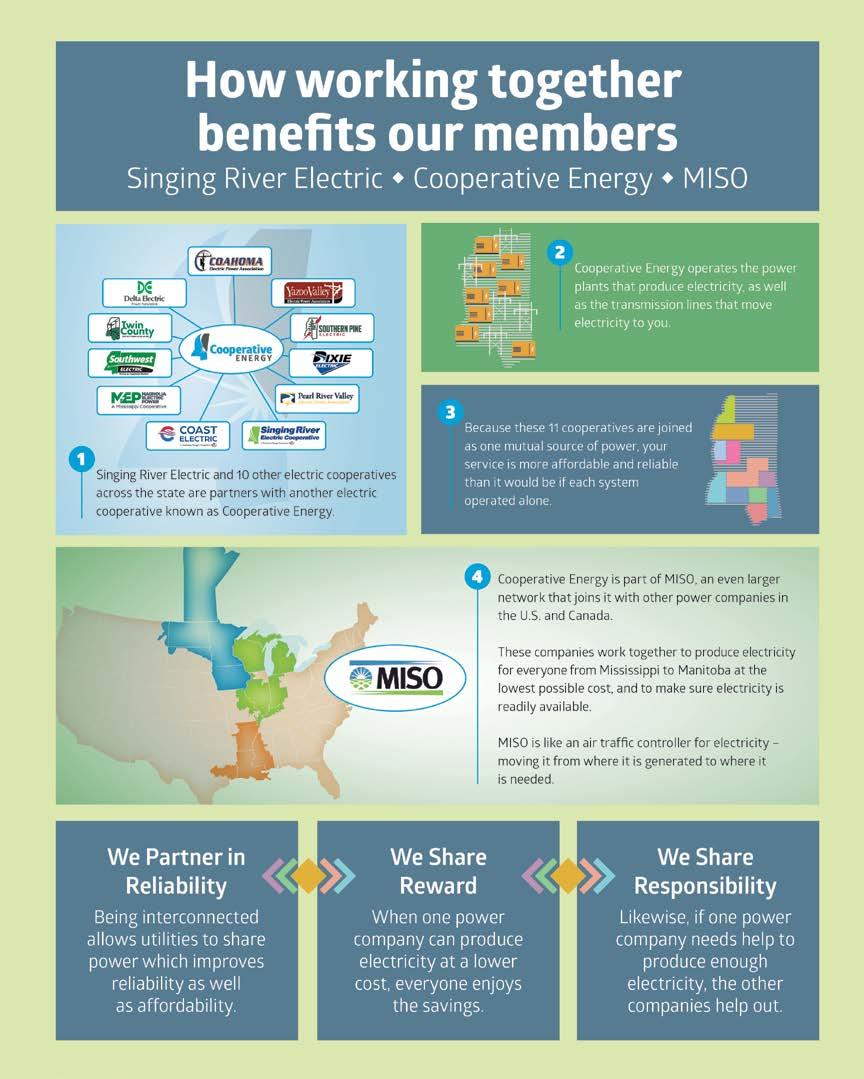








As we turn the page into July, I’m honored to greet you for the fi rst time as president and CEO of Southern Pine Electric. This marks a new chapter in my journey with the cooperative, one that began back in 2011 when I joined Southern Pine. I served as a district manager until I stepped into the role of vice president of administration in 2017, where I had the opportunity to work closely with teams across the organization and focus on the fi nancial health and daily operations that keep this cooperative strong. I’ve learned a lot over the years, and I’m excited to bring that experience into this new role.
July also brings with it the celebration of Independence Day, a time to reflect on the bold steps our nation’s founders took to create something new. They saw the opportunity to create an independent nation, conceived in liberty. Just like they saw opportunity in a fresh start, I see this leadership transition as a chance to build on our strengths, improve where we can, and continue delivering dependable service to our members. Southern Pine’s founding members understood the value of working together, and that spirit of cooperation still drives us today.
I’ve always believed in the importance of preparation and lifelong learning. I received my accounting degree from The University of Southern Mississippi, completed my MBA at Mississippi College, and went on to graduate from both the Mississippi School of Banking and the Graduate School of Banking at LSU. Through the National



Rural Electric Cooperative Association, I completed the Management Internship Program and earned my Cooperative Financial Professional Certificate. These programs deepened my understanding of what it takes to lead a successful cooperative.
I grew up in Simpson County and now live in rural Covington County with my wife, Tammy, and our four children. I’m proud to live in our service territory, work at Southern Pine, and be a part of powering the lives of our members and our communities.
At Southern Pine, our focus is simple: to serve our members by safely providing reliable and a ordable electricity while continually investing in the future. That future includes stronger infrastructure, more innovative technology, and a steady commitment to putting members fi rst. As we join our family, friends, and neighbors to celebrate our nation’s independence and the opportunities that come with new beginnings, I’m thankful for the trust you’ve placed in Southern Pine and in me.
I look forward to what we can accomplish together.

by Drummonds McAlpin
President/CEO Southern Pine Electric





Happy Independence Day








As we celebrate the birth of our nation, we’re reminded that new beginnings bring new opportunities. Thank you for the trust you place in us to power your lives — yesterday, today, and tomorrow.

Election to be held on Thursday, Nov. 13, 2025
For the purposes of electing directors, hearing and passing upon reports covering the previous fiscal year, and transacting such other business as may properly come before the meeting, the annual meeting of the members shall be held on the second Thursday of the month of November of each year, at such place in one of the counties of Mississippi within which the Cooperative serves, and beginning at such hour, as the Board of Directors shall from year to year fix; PROVIDED, that, for cause su cient, the Board of Directors may fix a di erent date for such annual meeting not more than thirty (30) days prior or subsequent to the day otherwise established for such meeting in this Section. Failure to hold the annual meeting at the designated time and place shall not work a forfeiture or dissolution of the Cooperative. It shall be the responsibility of the Board of Directors to make adequate plans and preparation for the annual meeting, and to encourage attendance by the membership at these meetings.
Section 4.03: Tenure and Qualifications
(a) At each annual meeting of the members, directors shall be elected by ballot, by and from the membership of the Cooperative, one director to be elected from each of the counties of Copiah, Covington, Newton, Scott, Simpson, Forrest, Jasper, Je erson Davis, Smith, Lawrence and Rankin Counties, Mississippi, each director to be elected for a term of three

(3) years, in accordance with the following formula, to-wit:
(1) At the annual meeting of November 1984, and every three (3) years thereafter, one director shall be elected from each of the counties of Copiah, Covington and Newton Counties, Mississippi, each of whom shall serve for a term of three (3) years from the date of election as provided by law.
(2) At the annual meeting of November 1985, and every three (3) years thereafter, one director shall be elected from each of the counties of Scott, Simpson, Forrest and Jasper Counties, Mississippi, each of whom shall serve for a term of three (3) years from date of election as provided by law.
(3) At the annual meeting of November 1986, and every three (3) years thereafter, one director shall be elected from each of the counties of Je erson Davis, Smith, Lawrence and Rankin Counties, Mississippi, each of whom shall serve for a term of three (3) years from the date of election as provided by law.
If the election of directors shall not be held at the annual meeting or if such annual meeting is not held, each director shall hold o ce until their successors shall have been elected and qualified.
(b) At any meeting, the Credentials and Election Committee shall determine the manner in which votes are to be cast and counted.
At any meeting, ballots shall not be necessary in the event the number of persons nominated for directors does not exceed the number of directors to be elected, but in such case if there be no objections, the directors may be elected in any other proper manner. Drawing by lot shall resolve, where necessary, any tie votes. If an election of
directors shall not be held on the day designated for the annual meeting, a special meeting of the members may be held for the purpose of electing directors within a reasonable time thereafter.
(c) No person or non-natural person as described in subsection (e) of this section shall be eligible to become or remain a director or to hold any position of trust in the Cooperative who is not an active member in good standing of the Cooperative, has not been a bona fide resident of the county from which they are to be elected for six months immediately preceding the nomination to directorship, or who is in any way employed by or financially interested in a competing enterprise.
(d) No person shall be eligible to become or remain a director who has been finally convicted of a felony or misdemeanor involving moral turpitude.
(e) In order to be eligible to become or remain a director of the Cooperative, a person must be a member of the Cooperative and receiving service therefrom, and not be a close relative as defined in Section 4.08 of an incumbent director, or the director being replaced. However, the operating or chief executive o cer of any member which is not a natural person, such as a corporation, church, etc., or its designee, shall, notwithstanding that they do not receive service from the Cooperative, be eligible to become a director, from the county in which such member is located, if they be so designated.
(1) Is in substantial permanent occupancy, direction or use of the premises served by the Cooperative, and

(2) Is a permanent resident within the county where such member is served by the Cooperative; provided further, that no more than one (1) such person may serve on the Board of Directors at the same time.
(f) No person shall be eligible to become or remain a director of, or to hold any other position of trust in the Cooperative, unless such person has the legal capacity to enter into a binding contract.
(g) No employee of the Cooperative shall be eligible to become or remain a director of the Cooperative.
(h) Upon establishment of the fact that a nominee for director lacks eligibility under this Section or as may be provided elsewhere in these bylaws, it shall be the duty of the chair presiding at the meeting at which such nominee would be otherwise voted upon to disqualify such nominee. Upon the establishment of the fact that any person being considered for, or already holding, a directorship or other position of trust in the Cooperative lacks’ eligibility under this Section, it shall be the duty of the Board of Directors to withhold such position from such person, or to cause them to be removed therefrom.
(i) Nothing in this section contained shall, or shall be construed to, a ect in any manner whatsoever, the validity of any action taken at any meeting of the Board of Directors, unless such action is taken with respect to a matter which is a ected by the provisions of this section and in which one or more of the directors have an intent adverse to that of the Cooperative.




































































COVINGTON COUNTY BOARD OF SUPERVISORS






Sheri Darrell Perkins, Southern Pine Director of Community Development Darnell Mo ett, and Under Sheri Ricky Lott.















MOSSVILLE VOLUNTEER FIRE DEPARTMENT


































Darnell Mo ett, Southern Pine director of community development, Chief Douglas Kelley, Assistant Chief Michael Chancellor, and Caroline Nurkin, Pinebelt Foundation director of operations.




SEMINARY ELEMENTARY SCHOOL



Darnell Mo ett, Southern Pine director of community development, Shannon Napier, assistant principal, and Caroline Nurkin, Pinebelt Foundation director of operations.
















































HEIDELBERG VOLUNTEER FIRE DEPARTMENT























TAYLORSVILLE HIGH SCHOOL




ALPHA KAPPA ALPHA (AKA) SORORITY, INC.
Darnell Mo ett, Southern Pine director of community development, Helen Milloy, Brenda Wiley, Breyon Magee, and Caroline Nurkin, Pinebelt Foundation director of operations.







Darnell Mo ett, Southern Pine director of community development, Fire Chief Prentiss Henley, Jr., EMR Fireman Larry Sappington, and Caroline Nurkin, Pinebelt Foundation director of operations.









Taylorsville Attendance Center students, faculty, and board members are pictured with Darnell Mo ett, Southern Pine director of community development and Caroline Nurkin, Pinebelt Foundation director of operations.















TAYLORSVILLE VOLUNTEER FIRE DEPARTMENT












KATINA’S CLASSROOM








Darnell Mo ett, Southern Pine director of community development, Fire Chief John Shoemaker, Assistant Chief Don Chennault, and Caroline Nurkin, Pinebelt Foundation director of operations.
















MOSSVILLE VOLUNTEER FIRE DEPARTMENT

Darnell Mo ett, Southern Pine director of community development, Chief Douglas Kelley, Assistant Chief Michael Chancellor, and Caroline Nurkin, Pinebelt Foundation director of operations.


SWEAT MORNING TEA, CORP.
Darnell Mo ett, Southern Pine director of community development, President Mary Gilmer, Oristean Epson, and Caroline Nurkin, Pinebelt Foundation director of operations.























Darnell Mo ett, Southern Pine director of community development, Katina Rankin, CEO/Founder, and Caroline Nurkin, Pinebelt Foundation director of operations.



















PAWS OF LOVE, INC.








Darnell Mo ett, Southern Pine director of community development, Jamie Kearney, Heather Calhoun-Kearney, and Caroline Nurkin, Pinebelt Foundation director of operations.


SYLVARENA VOLUNTEER FIRE DEPARTMENT
Darnell Mo ett, Southern Pine director of community development, Assistant Chief Patrick Parker, Chief Bryan Walters, and Caroline Nurkin, Pinebelt Foundation director of operations.



KEEP MAGEE BEAUTIFUL










Darnell Mo ett, Southern Pine director of community development, Eric Adkins, Christian Carrico, and Caroline Nurkin, Pinebelt Foundation director of operations.



































STRINGER VOLUNTEER FIRE DEPARTMENT
Darnell Mo ett, Southern Pine director of community development, Joe Stringer, Glen Myers, and Caroline Nurkin, Pinebelt Foundation director of operations.


TAYLORSVILLE CHAMBER OF COMMERCE
Darnell Mo ett, Southern Pine director of community development, President Rosalyn Glenn, Vice President Trey Gibson, and Caroline Nurkin, Pinebelt Foundation director of operations.










































SmartHub
Through the mobile app or online at southwestelectric.coop
Credit/Debit Card Draft
Enroll through SmartHub online or the mobile app for monthly auto pay or one-time payment
Bank Draft
One-time eCheck payment through SmartHub or call us to enroll in auto monthly bank draft
Pay by Phone 24/7
Call 844-975-2728 and pay with credit/ debit cards or by eCheck
Pay Centers
• Lorman — Southwest Electric o ce
• Port Gibson — River Hills Bank
DirectPay
• Barcode in SmartHub or back of bill
• Barcode in SmartHub or back of bill
• $1.50 fee
• Find nearest location in SmartHub
MoneyGram
• Available at Walmart and CVS stores
• $1.50 fee
• Receive code 16381
U.S. Mail
Mail your bill stub and check or money order to P.O. Box 5, Lorman, MS 39096
Regular Billing

























Standard billing is familiar to our Members. Pay for use as metered on a monthly basis.










Alternate Payment Dates






Choose to have payments due on the 15th or 27th of each month, allowing for flexibility with your budget and schedule.
































Only requires $105 to start service – $55 is a credit towards electricity use –and no deposit. Pay for use as you go. Available for new and existing Members.







Variable Monthly Payment
Calculates and averages the last 11 months of use plus the current month’s use, providing a levelized current bill. Makes monthly budgeting easier. EZ-Pay

Paperless Billing





























No more paper bills in your mailbox. Receive notification of your bill by text or email.









































AUG. 13, 2025
Members attending will be eligible for EXCITING DOOR PRIZES.
CAN’T ATTEND? Return the bottom portion of your Annual Meeting Notice for a chance to win one of 10 $100 BILL CREDITS.
DEADLINE: AUG. 8 AT 4:30 P.M.
WEDNESDAY, AUG. 13, AT 10 A.M.
Southwest Electric’s bylaws can be found at southwestelectric. coop/what-is-a-cooperative or by scanning the QR code.
The Nondiscrimination Statement can be found at southwestelectric. coop/nondiscrimination-statement or by scanning the QR code.
You can also call our office to obtain copies.
Member Services employees recently participated in Franklin County’s AJFC Community Action Agency’s Community Awareness Day. They talked to Members about the options available in the SmartHub app and shared energy e ciency tips in Meadville on May 15.

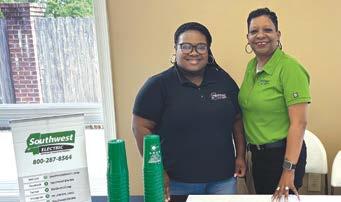

Cooper the Owl says:

















Cooper the Owl spots dangers overhead. Look up when trimming trees, fl ying drones, or carrying long tools. Always maintain at least 20 feet of clearance from power lines. Visit BeAwareEverywhere.com for more safety tips.


































Now is the time to switch your ceiling fans, so they are turning counterclockwise for the summer. You want the air circulating downward to create a chilling e ect on your skin making you feel cooler. Remember, fans cool people, not the air in the room. It’s also important to remember to turn your ceiling fans OFF when you are not in the room to save energy. Every little bit helps.



Turn your ceiling fans OFF when you are not in the room.
Enter your cell phone number in the SmartHub app or on the website. (See instructions for the app and website below.) Validate your cell phone number with a code received via text from SmartHub.

































SERVING MORE THAN 12,600 ELECTRIC METERS IN SEVEN DELTA COUNTIES
Hollandale - 662-827-2262 | Belzoni - 662-247-1909 | Greenville - 662-334-9543 | Rolling Fork - 662-873-4233 | REPORT OUTAGES 866-897-7250 @twincoepa twincoepa.com




Twin County Electric Power Association implemented its first rate adjustment in nearly eight years, e ective June 1, 2025.
Several factors influenced the rate adjustment:
• Increased fuel costs for natural gas, coal, and other resources used in power generation.
• Regulations and environmental policies established by federal and state agencies.
• Inflation of the cost of goods and services.
• Supply chain deficiencies and increased costs of critical infrastructure and materials, including transportation expenses.
• Weather-related events, such as tornadoes, straight-line winds, and extreme temperature fluctuations.
• Increased energy consumption.
In the past five years, wholesale power costs have continued to rise. Twin County purchases its electricity solely from Cooperative Energy, a generation and transmission cooperative owned by Twin County and 10 other electric cooperatives in Mississippi. In May 2025, Cooperative Energy’s Board of Directors voted to raise the power cost adjustment component of Twin County’s power bill by 3.00 mills/kWh.

member rates. We understand that any increase in rates can be concerning, and we are committed to maintaining reliable service while being sensitive to the needs of our members.
During this challenging period, Twin County has taken proactive measures to minimize costs. The organization has been diligently working on optimizing energy supply and improving operational e ciencies to help lessen the financial burden of providing service to our members. After careful consideration, the board of directors authorized an independent organization to conduct a cost-of-service study. This study evaluated the capacity requirements and expenses related to delivering reliable electricity for each rate class served by Twin County. Based on the results of the study, the board approved the necessary rate adjustment.
On average, a residential home using 1,000 kilowatt-hours per month will see an increase of approximately $12.00. We empathize with our members and understand how a rate adjustment can impact your household budget. To assist our members during this transition, we will provide information about your monthly energy consumption and share resources for energy-saving tips.

Wholesale power costs account for approximately 75% of your monthly bill. As a not-for-profit electric cooperative, we adjust member rates only when the actual cost of delivering reliable power exceeds our operating expenses. Twin County’s Board of Directors and management remain focused on streamlining operations and minimizing costs when contemplating any changes to

Your membership contributes to the sustained growth and stability of Twin County, and we want our members to understand the value of their electric service and the benefits of being a member of an electric cooperative.



by Leslie Holloway
General Manager










by Scott Flood
Don’t generate problems with your backup generator.
The wind howls outside your windows as a major storm system blows through the area in the late evening. Your lights flicker for a moment or two before you’re plunged into darkness.
Fortunately, you had the foresight to buy a backup generator big enough to handle your refrigerator, freezer, and other key needs.
Mississippi’s electric cooperatives understand power outages are a major inconvenience, and we do our best to prevent them. But when severe weather rolls through, outages can sometimes stretch into several hours or even days after a major storm. Lineworkers may have to check many miles of power lines to pinpoint the problems before they can begin their work to restore service. That’s why many co-op members consider buying backup generators to provide for their family’s needs while waiting for service to resume.
Backup generators fall into one of two categories. Standby generators are permanently wired into the home’s electrical system by a qualified electrician. Portable generators, as the name implies, can be moved to wherever they are needed. Because they’re small enough to move, they generally provide less power than standby models.
Some homeowners make the mistake of plugging their backup generators directly into a wall outlet or connect them to their home’s electrical panel. Beyond the significant risk of electrocution and fire that can create, plugging generators directly into your outlets can send the voltage your generator creates into the power lines connecting your home to the electric grid. That creates a dangerous condition called “backfeed,” which can seriously injure the lineworkers who are working so hard to restore your electricity, as well as anyone who accidentally comes in contact with power lines.
That’s why permanently installed backup generators are required to have what’s known as a transfer switch, which should be installed by a qualified electrician. The transfer switch creates a barrier between your home’s electrical system and the outside wires, so backfeed cannot occur. When the transfer switch senses that power has been restored, it switches the power from the generator back to the outside lines.
The biggest danger associated with backup generators is one that’s both invisible, odorless, and deadly. Because backup generators burn fossil fuels, they generate a variety of gases, most notably carbon monoxide. The agency reports that nearly 100 Americans lose their lives each year because of CO poisoning from backup generators. That’s why generators should only be used in dry, well-ventilated areas away from your home and garage.




CO has the potential to kill in as little as five minutes. People exposed to CO typically become dizzy, feel nauseated, and experience headaches. Often, they lose consciousness before noticing any symptoms. Anyone exposed to CO should be moved to fresh air immediately.
If you purchase a portable backup generator, protect your home and family by taking the time to read the manufacturer’s instructions. Don’t use portable generators in rainy or wet conditions unless you keep them shielded from moisture and well-ventilated.
When starting a portable generator, make sure nothing is plugged into it. In addition, you can reduce the potential for damage to your appliances and lighting by turning them o or unplugging them from the wall. After the generator starts, plug them in and turn them on one at a time to make sure you aren’t overloading your generator’s capacity. Unplug them from the generator before turning it o . Unless the manufacturer recommends otherwise, always turn the generator o and allow it to cool before adding fuel.
Finally, as with many home appliances, regular maintenance is the key to ensuring your portable generator operates safely for years to come.
For more than four decades, business writer Scott Flood has worked with electric cooperatives to build knowledge of energy-related issues among directors, sta and members.













How do I improve the e ciency of my older home while keeping its charm?

by Miranda Boutelle
Start by prioritizing the invisible upgrades that make your home more comfortable and e cient. When we were kids, I don’t think any of us thought, “When I grow up, I want to spend my hard-earned money on insulation.” It’s not as exciting as new countertops or a remodeled bathroom, but air sealing and insulation can save you money every month. Then you can apply the savings to aesthetic improvements.
Many older homes are not properly insulated. Insulation has several benefits beyond sealing your home and keeping outdoor air from seeping in. It reduces outdoor noise, makes your home quieter and improves your overall comfort.
Always properly air seal before you insulate. Older homes with pocket doors, coved ceilings, dumbwaiters, doors to attic spaces, and laundry chutes allow indoor air to escape through the cavities, gaps and cracks around these classic features. Sealing o open cavities around those features often requires plywood, rigid foam, or drywall fastened into place and then caulked around the edges.
Keep an eye out for framing features that cause drafts. Balloon framing is a type of construction where wall studs run all the way from the foundation to the roof, allowing air to flow freely through those spaces. Second floors with knee wall attics on both sides are notorious for air leakage. Open cavities allow air to flow horizontally between the attic spaces, making the home uncomfortable and ine cient. Seal o the open cavities in the floor framing and insulate attic spaces.
Dense-packed cellulose or closed cell foam insulation can be sprayed into exterior walls. Skilled contractors can remove pieces of siding and drill holes to fill the wall cavities from the outside of the home. For brick or stone homes, holes can be drilled from the inside and then patched and painted. Insulating walls from the inside of the home requires more time and e ort in preparation and cleanup, but having well-insulated walls is worth it.
Knob and tube wiring — commonly used from the early 1880s to the 1930s with no grounding wire — should be replaced prior to insulating walls and attics for safety purposes. Contact between insulation and knob and tube wiring can create a fire hazard.
People often think new windows are the best way to improve a home’s e ciency. Considering the cost of replacing windows,



AI love old homes. The details and craftsmanship have always drawn me to them. The features of older homes can make them less e cient than modern construction, but it doesn’t have to be that way. You can keep the charm and make your home more e cient.

I recommend investing in air sealing and insulation first. Then consider storm windows to keep the charm of the original windows, such as leaded glass and stained-glass windows in good condition. Choose from interior or exterior options that are operable and inoperable.

Prioritize the invisible upgrades that make your home more comfortable and e cient, such as adding blown-in insulation to your attic. Photo Credit: Bonneville Power Administration
Once you’ve addressed the envelope of your home, consider appliance improvements. Replace your old electric water heater with a heat pump water heater. This upgrade can save a family of four an estimated $550 per year and more than $5,600 over the lifetime of the water heater, according to ENERGY STAR®. Invest in high-e ciency heating and cooling equipment. A mini-split heat pump, also known as a ductless heat pump, is a more e cient option than electric baseboard heating and provides the benefit of air conditioning.
Older homes don’t have to be ine cient. Show your home some love and invest in energy e cient upgrades.
Miranda Boutelle is the chief operating o cer at E ciency Services Group in Oregon, a cooperatively owned energy e ciency company.



























NRECA voting members (“Members”) have the right to use, distribute, reproduce, publish, and publicly display in any media whatsoever (“Use”) any graphic contained in the Straight Talk library (“Graphics”) for the purpose of promoting their business. Members are permitted to modify Graphics for the purpose of incorporating their respective names and logos within a Graphic. Members are also permitted to resize or alter the layout of a Graphic to fit the dimensional needs of a particular publication; however, Members shall neither crop nor edit the Graphics as to substantially change or modify the original design





Members are not permitted to Use only portions of a Graphic. Members also may not sub-license, sell, lease, or rent Graphics to third parties. Members must include any attribution or source language if any is contained in the original file.







Co-op Owned Equipment vs Member-Owned Equipment

equipment owned by the co-op (in gold) and the member (in blue). any equipment owned by the co-op, we are responsible for damages any member-owned equipment, the member is pairs. Members should hire a licensed electrician epairs to member-owned equipment.
As July rolls in with longer days and rising temperatures, it also brings the increased potential for severe weather. Summer storms can arrive quickly and hit hard, sometimes causing significant damage to essential electric equipment throughout our community.
Yazoo Valley Electric Power Association is always prepared to respond swiftly to outages and restore power safely, but it is also important for homeowners to understand which parts of the electric system are their responsibility and which are maintained by us at the co-op. Understanding these key di erences can help speed up repairs and ensure everyone stays safe when the weather turns rough.
If you have a questions pertaining to this Policy, please contact Abby Berry at abby.berry@nreca.coop or 571-319-6231.










Yazoo Valley is responsible for maintaining and repairing the equipment and lines that run to your home, including utility poles, distribution power lines, electric meters, and padmounted transformers. Yazoo Valley members are responsible for the equipment located between the electric meter and your home or business. Members are also responsible for the weatherhead and service mast located outside the home.
If any equipment that you (the homeowner) are responsible for is damaged, please call a licensed electrician to conduct the repairs. A professional has the experience and know-how to assess and manage these types of repairs.
When severe weather damages electrical equipment, it’s important to note that any necessary repairs to the homeowner’s equipment must be conducted before Yazoo Valley crews can restore power to your home or business. By understanding the equipment you are responsible for, the repair and restoration process will be smoother and faster.
Our community takes great pride in the beautiful trees and landscaping that contribute to the natural beauty where we live, however, regular trimming is essential to ensure reliable electric service and minimize damage from severe weather. Yazoo Valley regularly trims trees throughout our service territory to improve service reliability. If you spot a tree limb that is obstructing a distribution power line outside your home, please call Yazoo Valley Electric Power Association, so we can trim those limbs and maintain those lines.
Any overgrown limbs or vegetation around the service line is the homeowner’s responsibility, and in these cases, please call a professional tree trimming service to assist. By working together to understand the essential equipment that powers daily life, we can all be better prepared to start the repair and restoration process if severe weather impacts our community.
This graphic depicts equipment owned by the co-op (in gold) and the member (in blue). If a storm damages any equipment owned by the co-op, we are responsible for repairs.


















Yazoo Valley Electric Power Association was proud to sponsor the Lights Out softball team for the second straight season. Yazoo Valley is a strong supporter of local youth sports. Congratulations to all our young athletes on a great season.




I am a fan of Jamie Dimon and have been for many years. Dimon is the CEO and Chairman of the Board of JPMorganChase, the largest U.S. bank by assets, and when Dimon talks, the world listens. While giving an interview at the Reagan National Economic Forum in May, Dimon caused a stir with his answer to the question, “Do we need to rethink what constitutes national security?”
His answer, “We know what constitutes national security. We don’t need to be stockpiling bitcoin; we need to be stockpiling guns, bullets, tanks, planes, drones, and rare earth minerals.”
The media seized on that answer and suddenly Dimon was everywhere — on social media and the national news networks. Perhaps you have heard about or seen his comments already.
While Dimon’s answer may have been an awakening to some, it was comments he made later in the interview that really struck a nerve with me. When talking about the national deficit and what needs to be done to curtail spending, Dimon told the interviewer that there were 13,000 lobbying groups in Washington, D.C. He said 10 or 12 belonged to the banks, but the rest lobby for cotton, corn, sugar, unions, and every possible business or interest you can imagine. All of them are coming to D.C. and wanting to either start a new program or keep an existing program going. Dimon said this was damaging our country, and we need a “Reagan Type” to convince Americans that the time had come to sacrifice personal interests for the common good.
The comments made my heart sink because that is what I do, both in Jackson and D.C. I act on behalf of our electric cooperatives to ensure that they can deliver a ordable, reliable power in a manner that is environmentally conscious. Is asking that the






Rural Utility Service and Federal Emergency Management Agency (FEMA) be fully funded hurting our country? Is LIHEAP a bad program? (LIHEAP is an energy assistance program that helps low-income families pay utility bills.)
As I sat there pondering Dimon’s words, I thought about how my board would feel about me if I did not deliver on those issues. I also wondered how the clients of those 13,000 lobbyists would react to their “special interest” not being passed. My guess is they would all be unemployed. I remember our former U.S. Senator Trent Lott once famously said, “If money goes to another state, it’s called pork spending, but when it comes to Mississippi, it’s economic development.”
I asked AI what our national debt was. The answer was $36.2 trillion as of April 2025. That figure includes debt that is owed to the public (including other countries) and debt owed between government agencies. Honestly, that number is di cult for me to comprehend.
This month America will celebrate its 249th birthday. Maybe it is time that we as Americans do some soul searching and decide what is important to us. Do we continue with this current course of self interest and leave our posterity crippling debt and a bleak future? Or do we become good Americans and set aside personal interest, so our country can last another 249 years? The choice is ours to make, but our children will have to live with it.
Happy Birthday, America!


by Michael Callahan
Executive Vice President/CEO Electric Cooperatives of Mississippi







Always be cautious of unsolicited calls (or in-person visits) to your home from companies claiming to conduct energy audits. These are typically telemarketing firms that claim to be a third-party company or pose as a representative from your electric utility to gain access to homes and sell services with the promise of government rebates. Many electric utilities provide energy audit services, but they are typically scheduled at the member’s request.
Source: Better Business Bureau



























































































